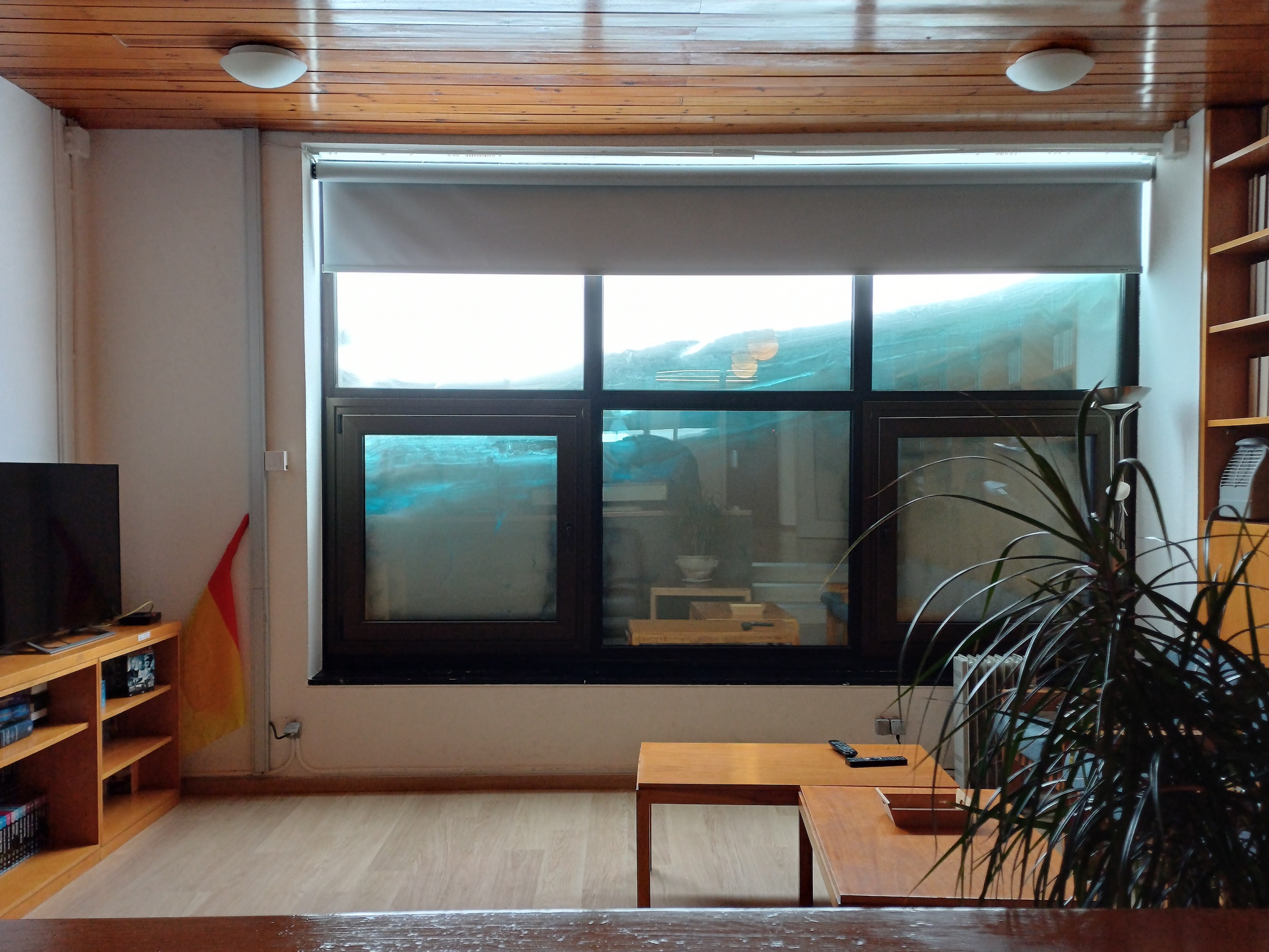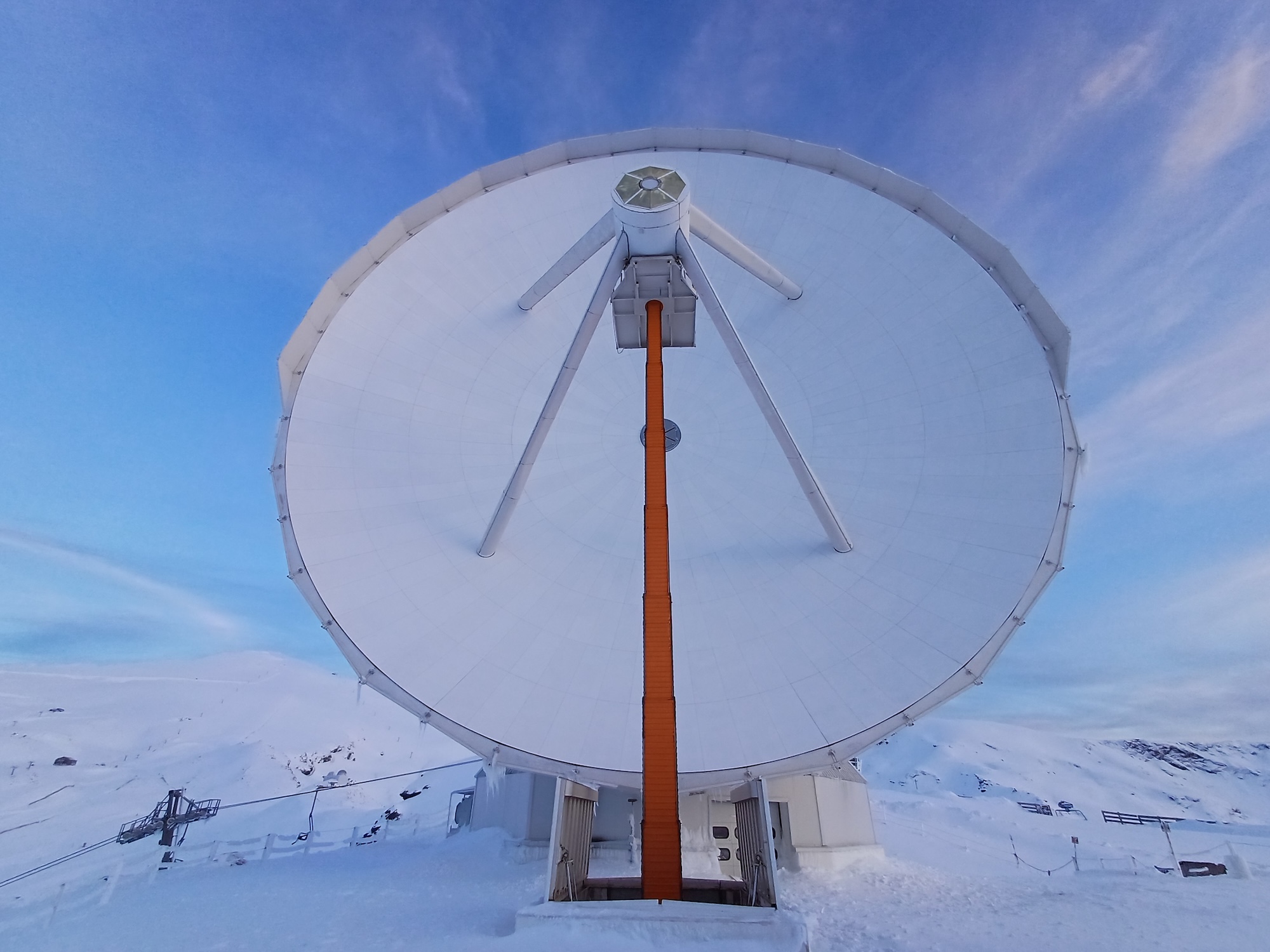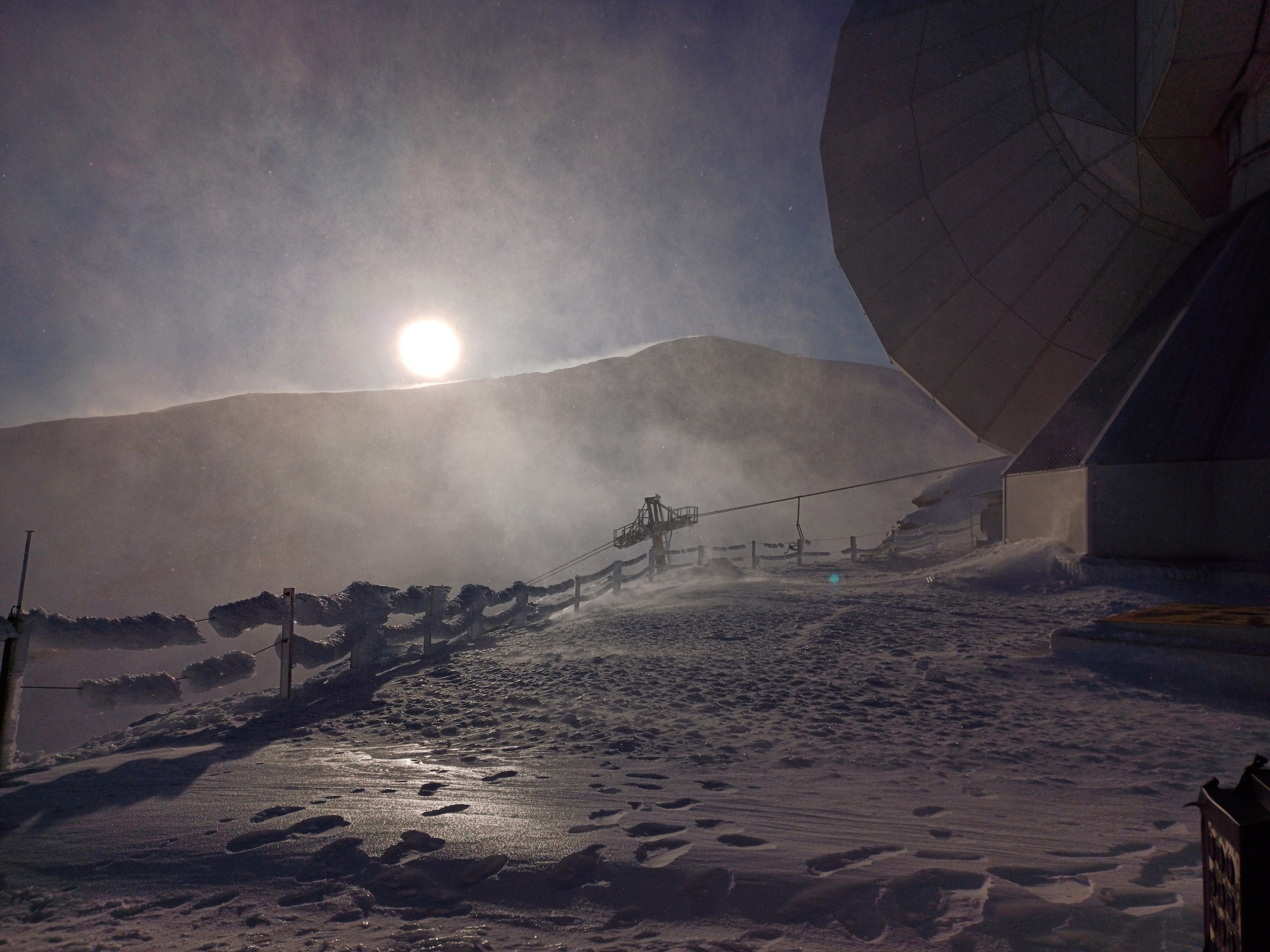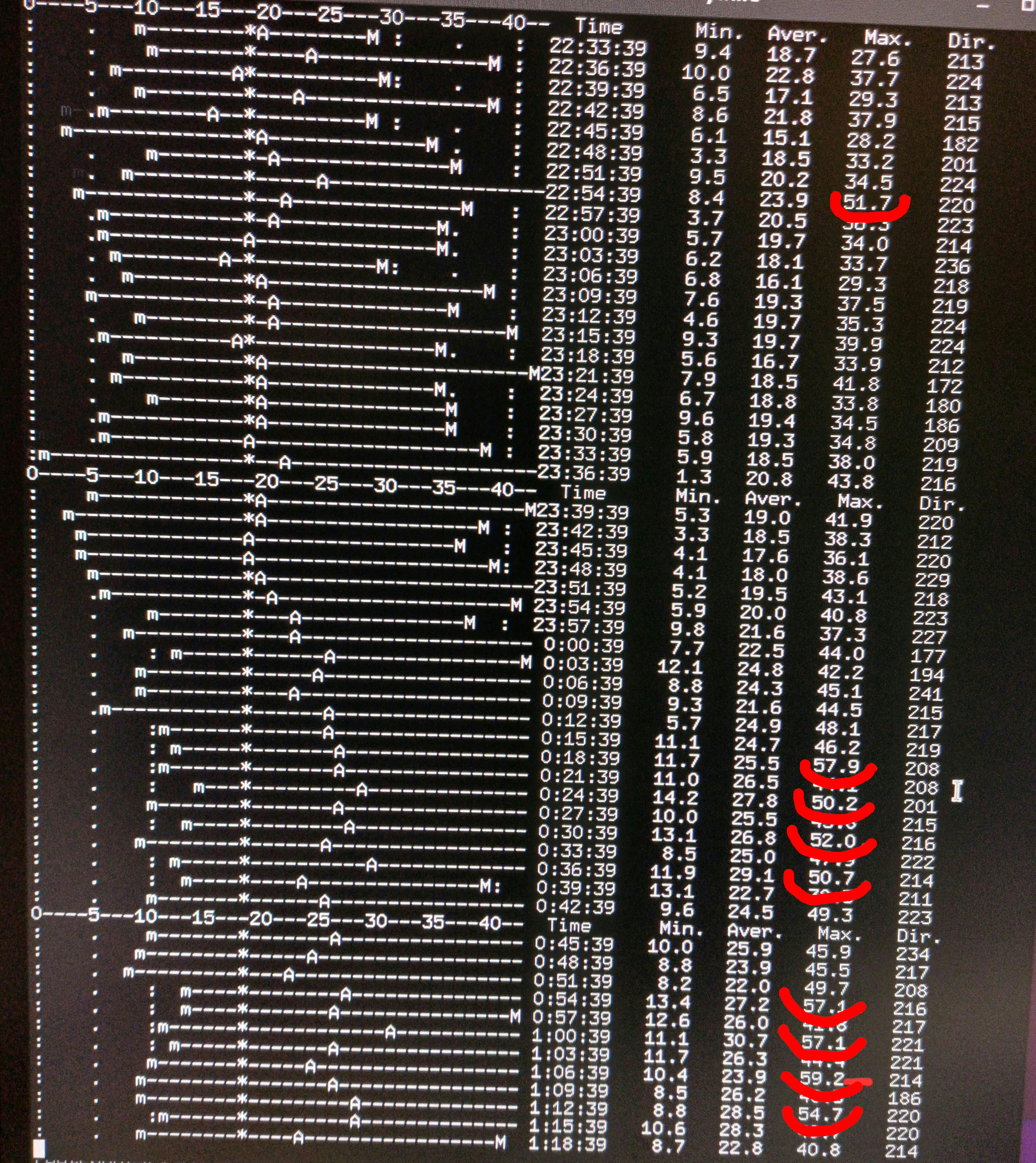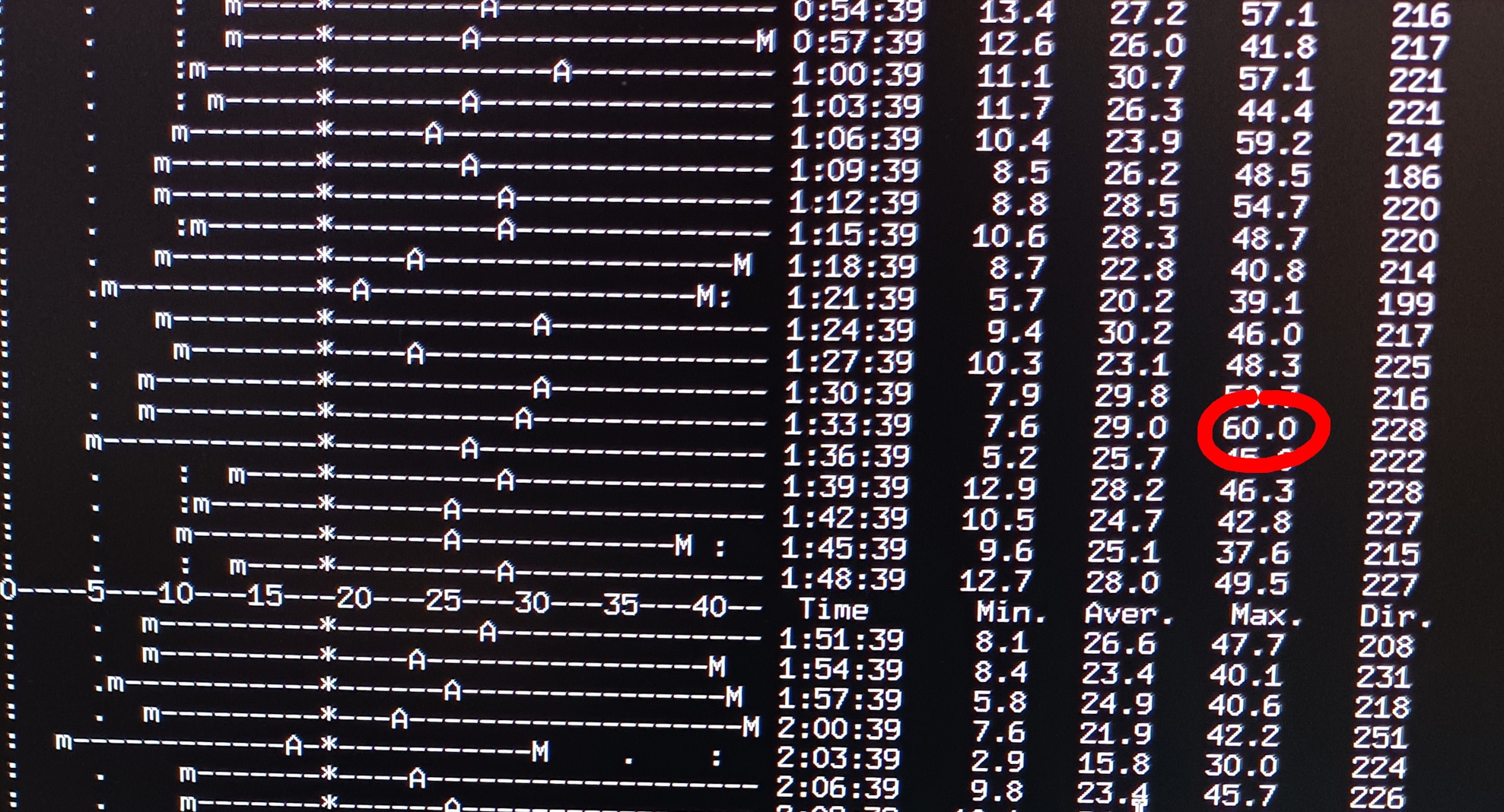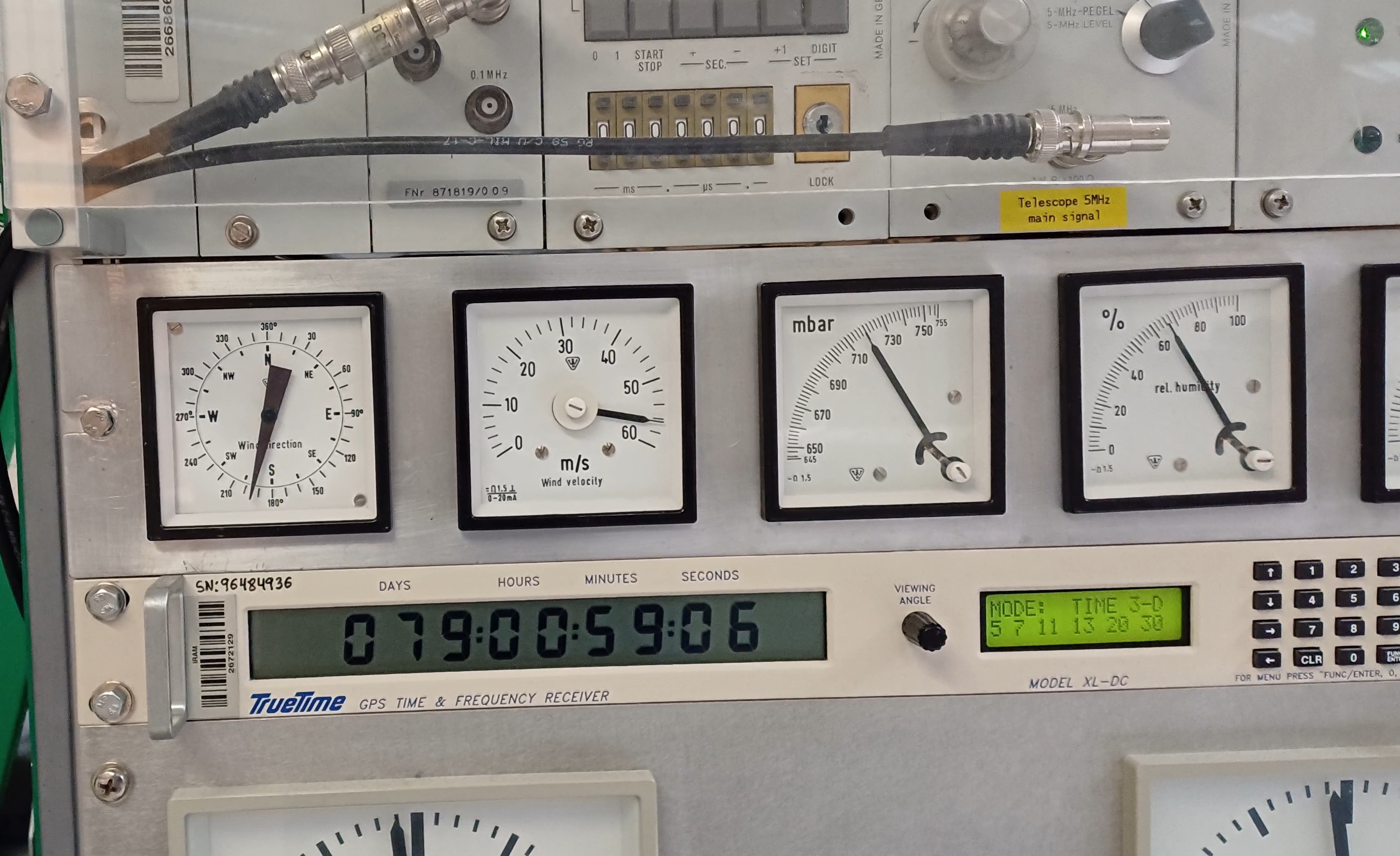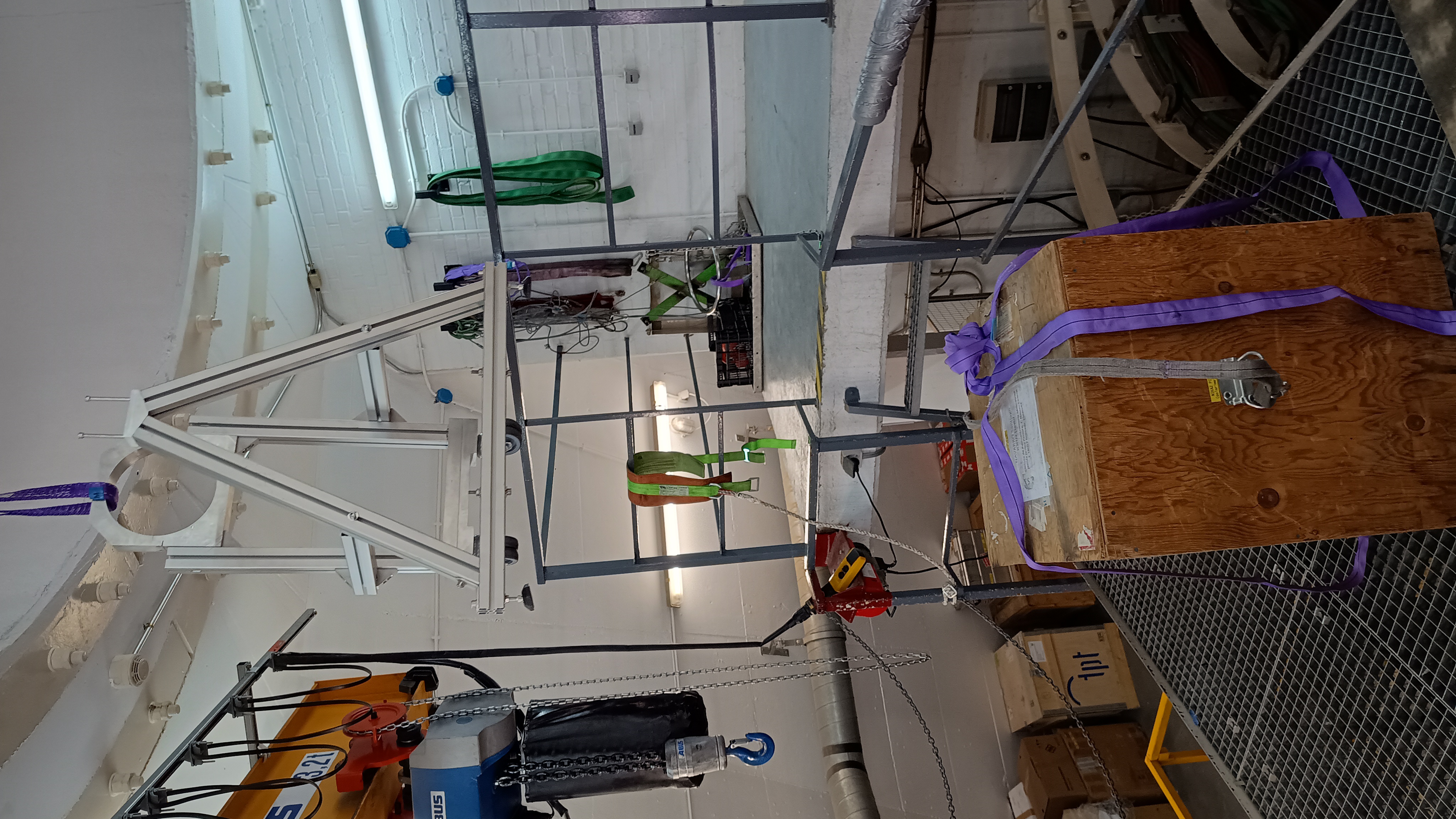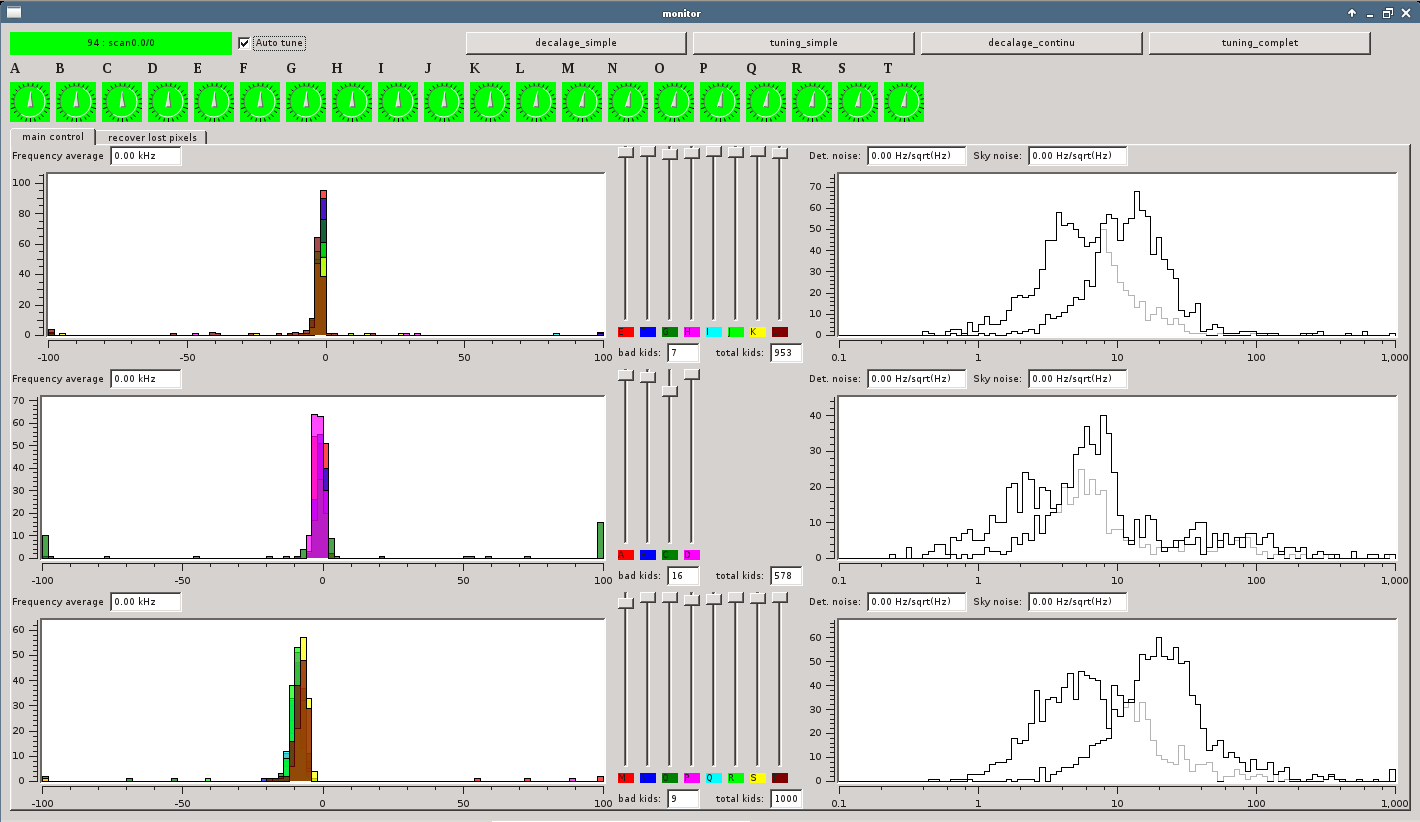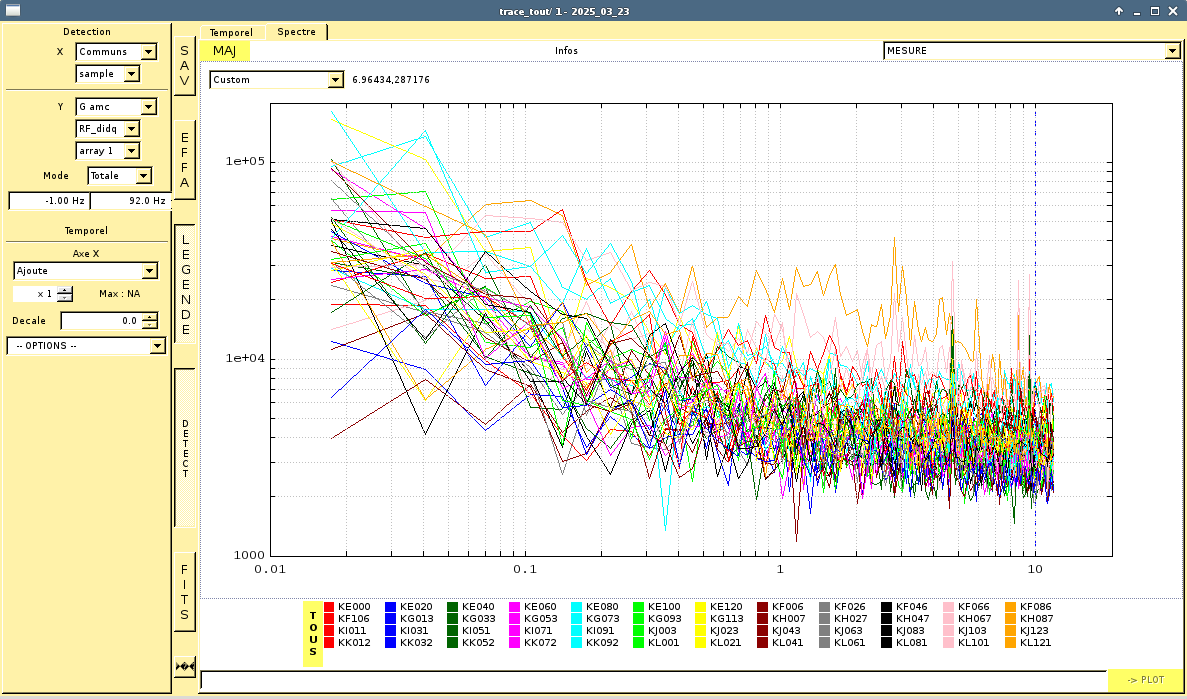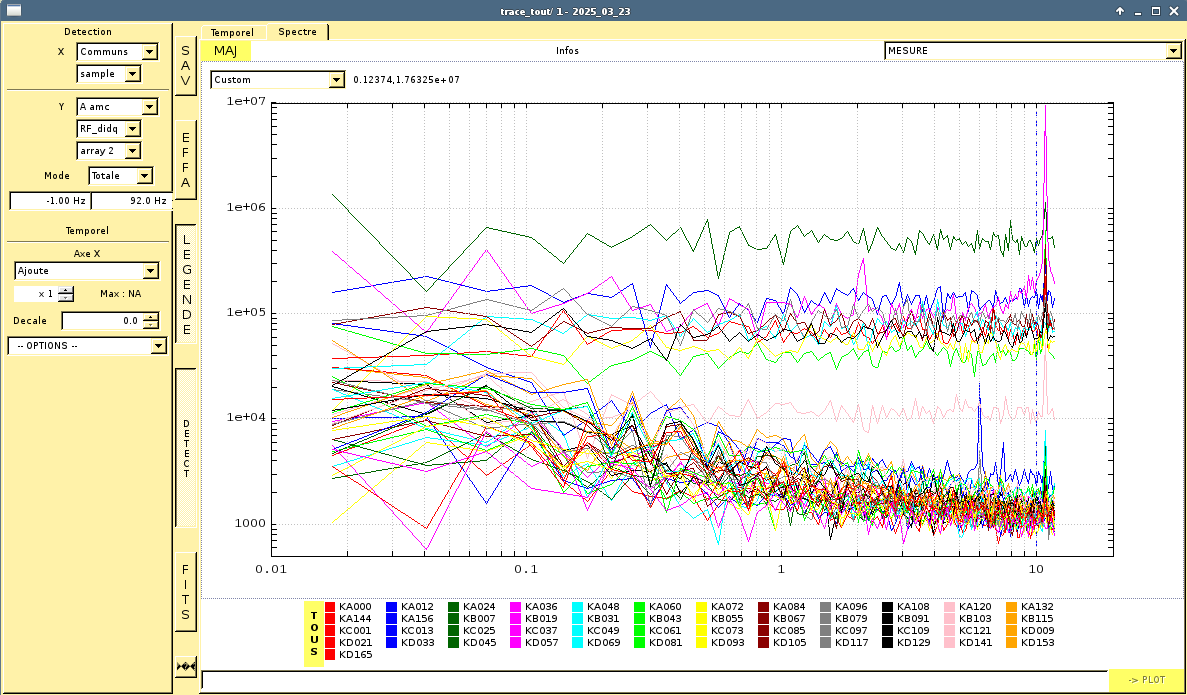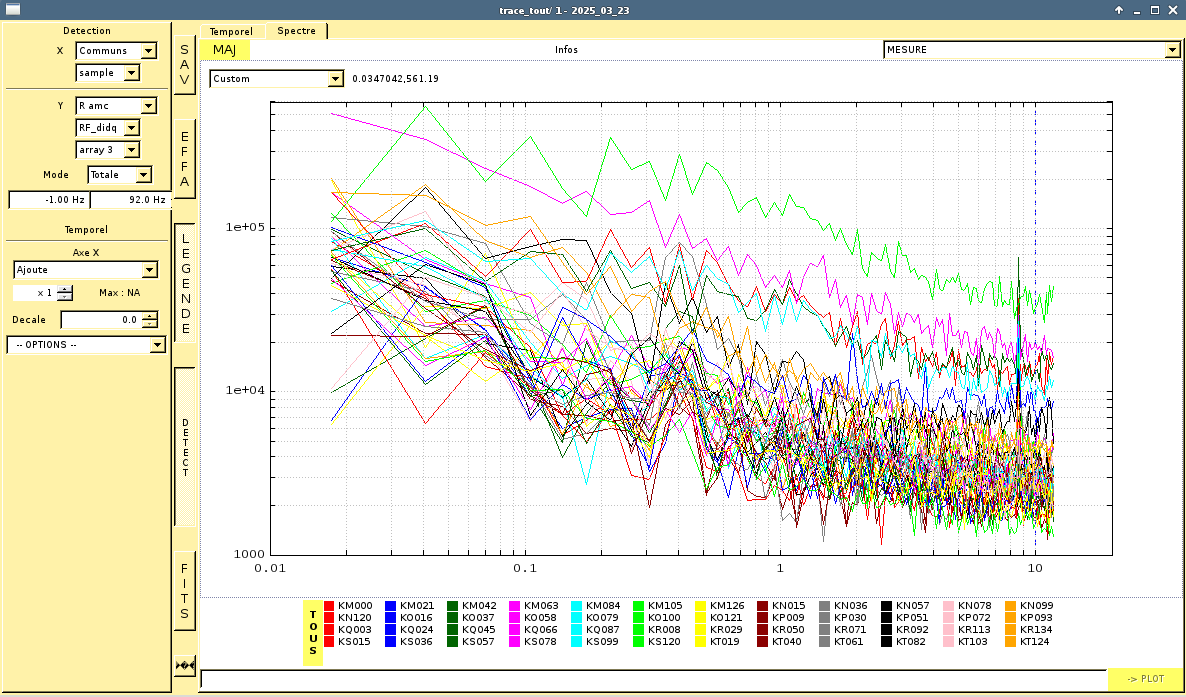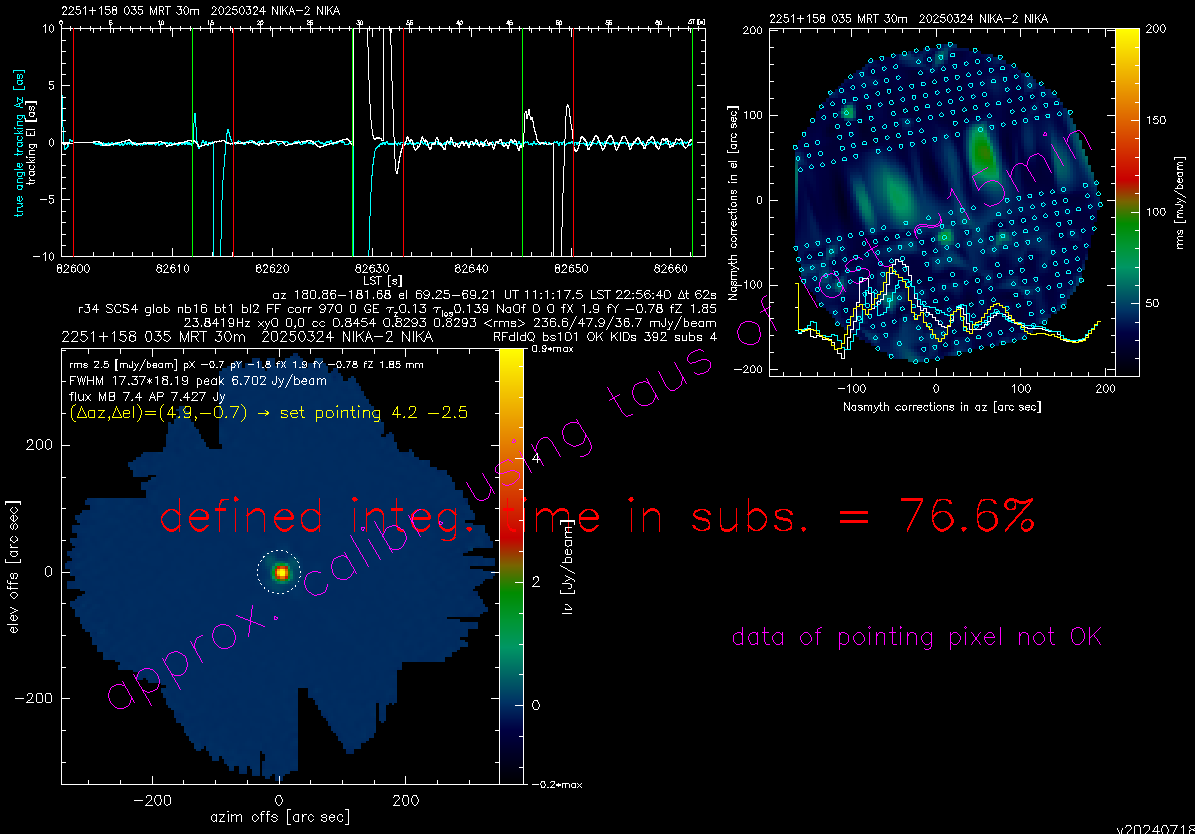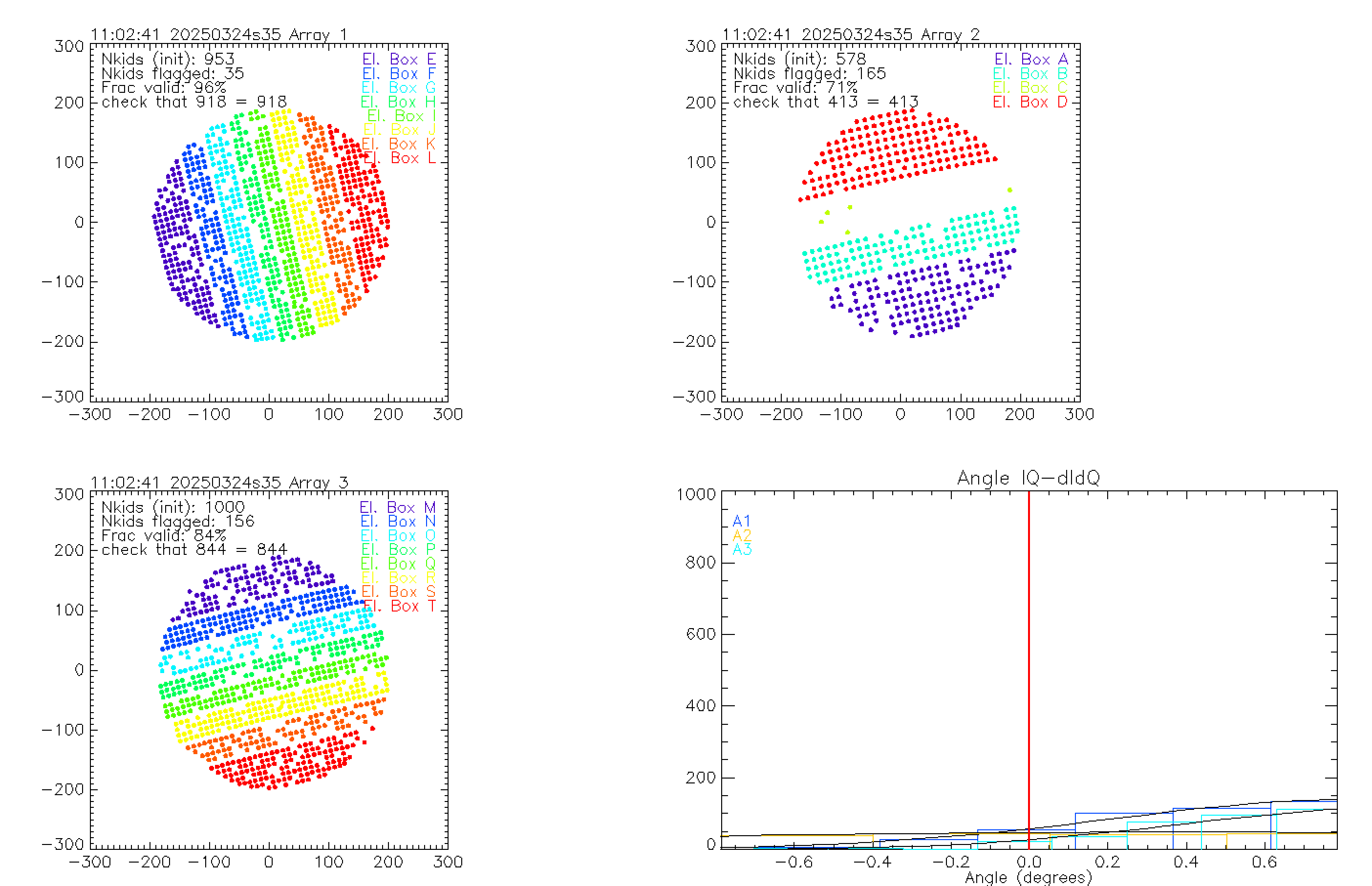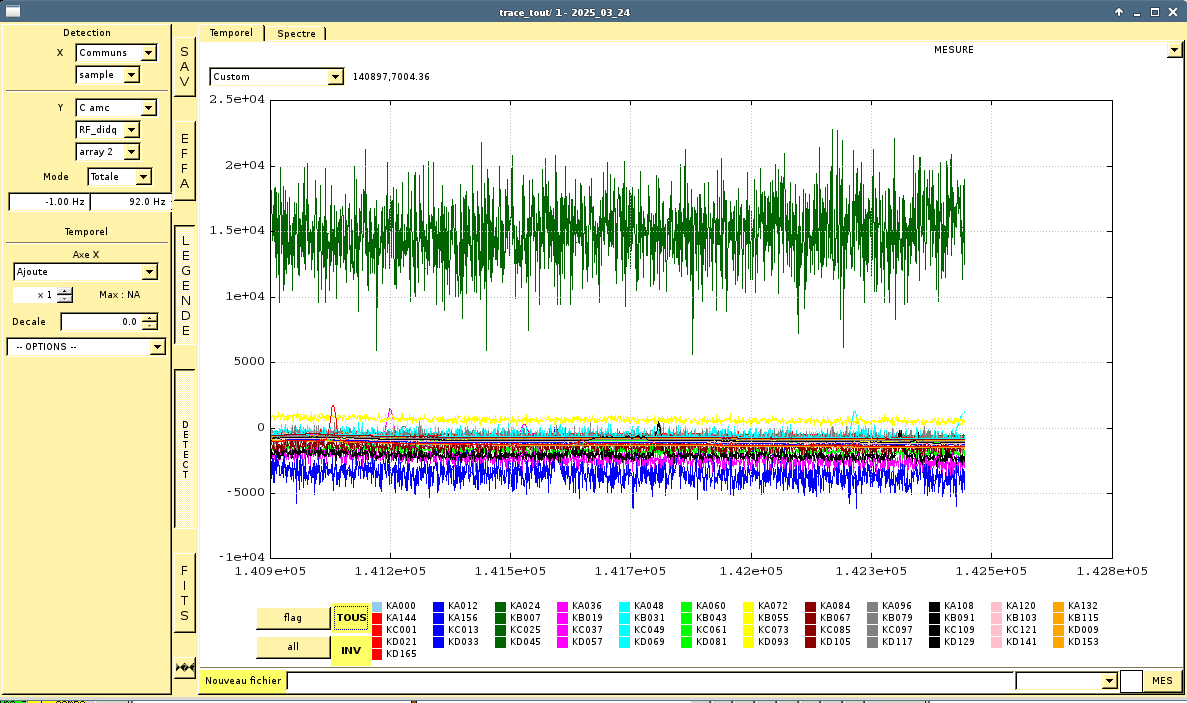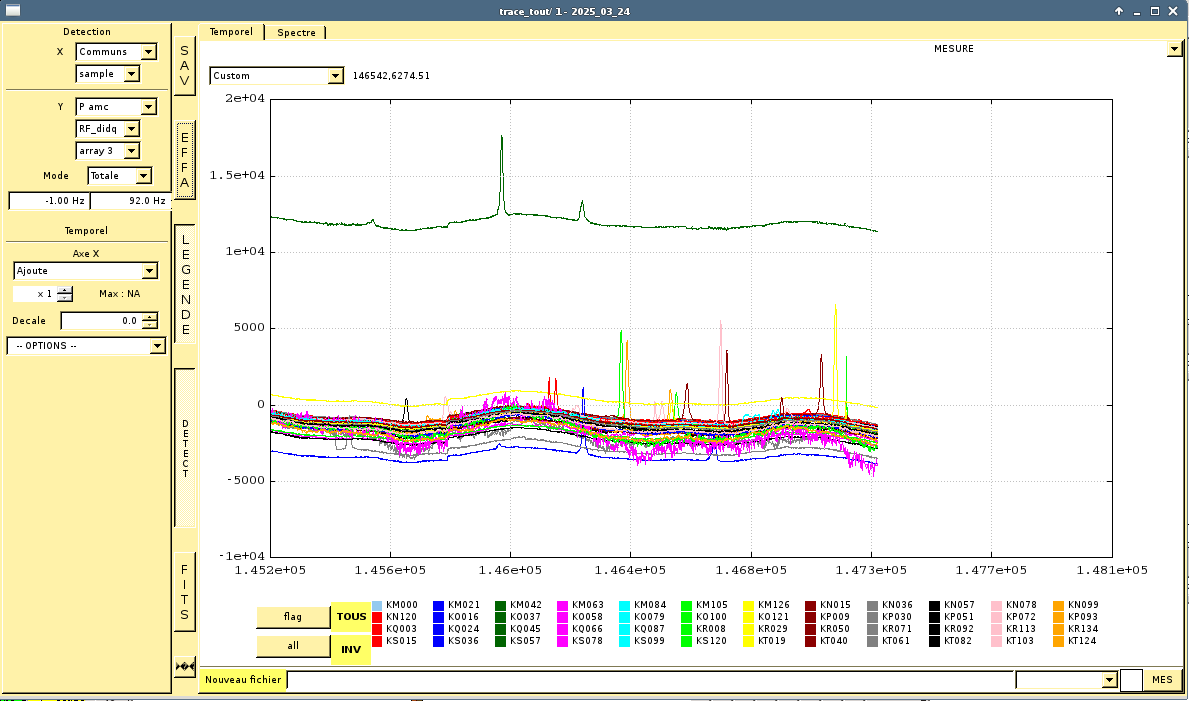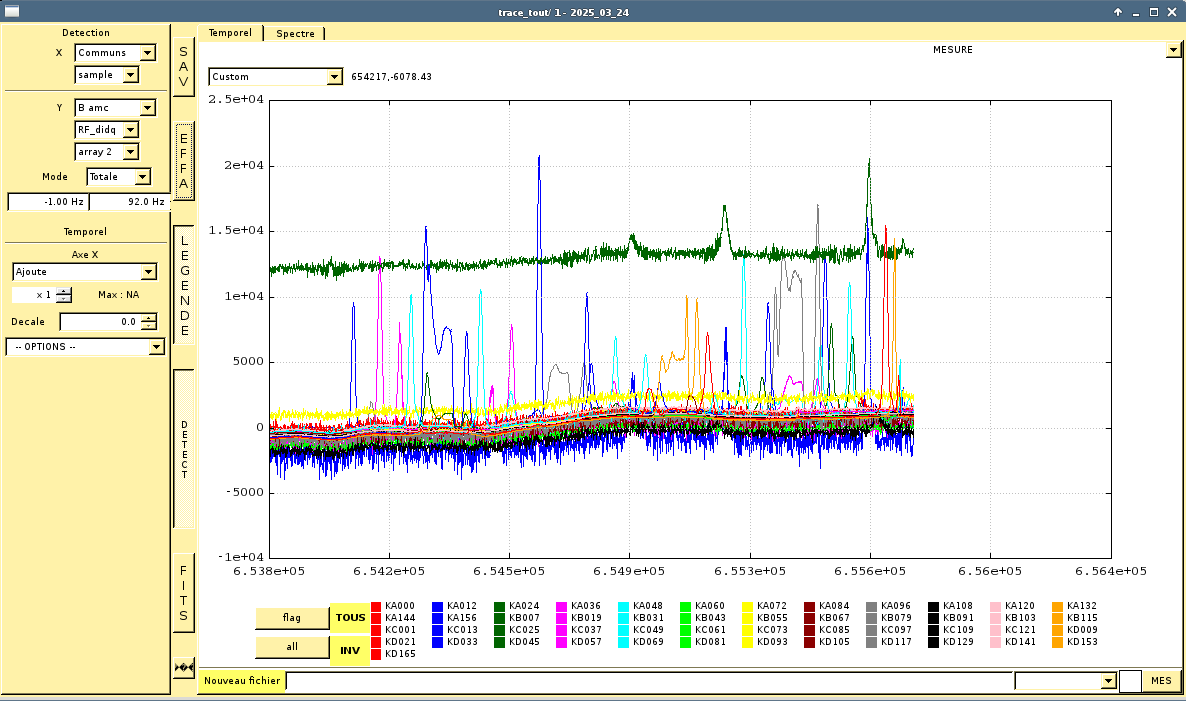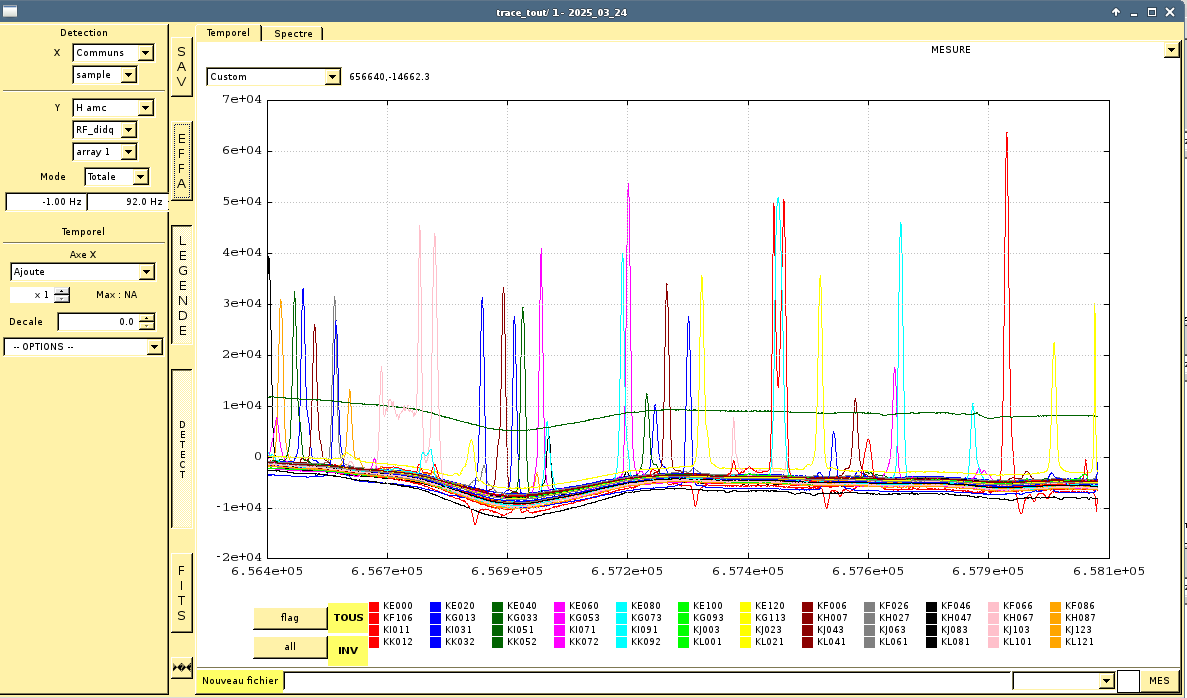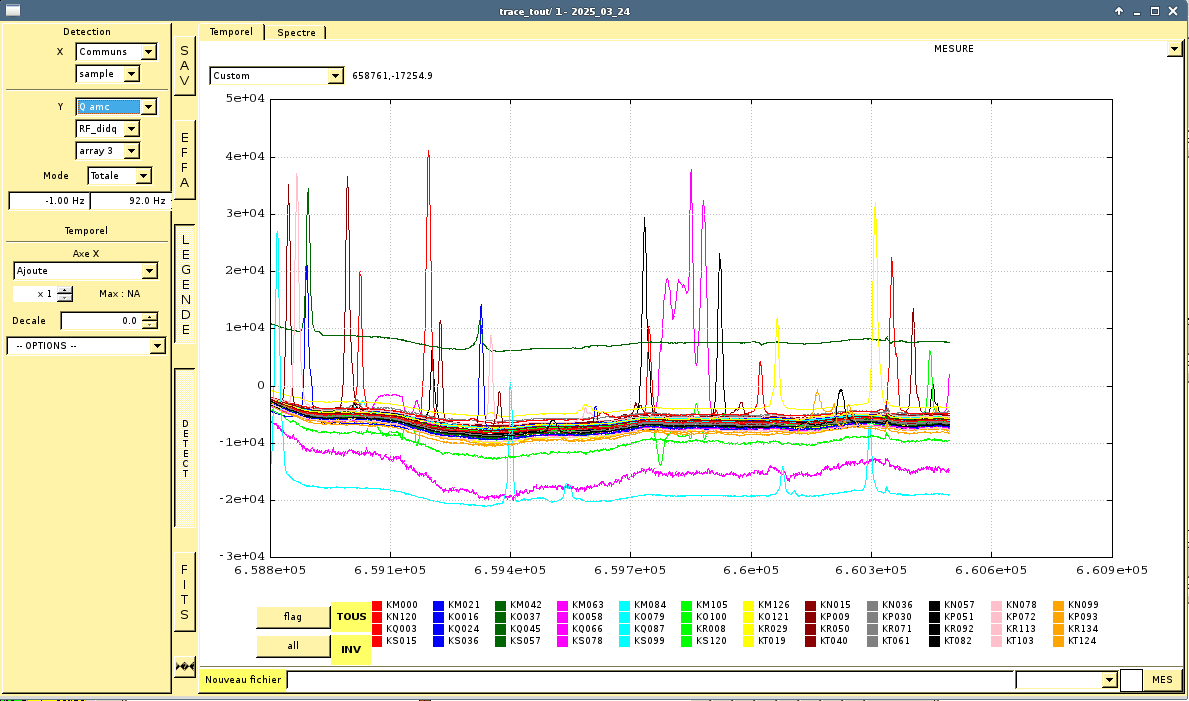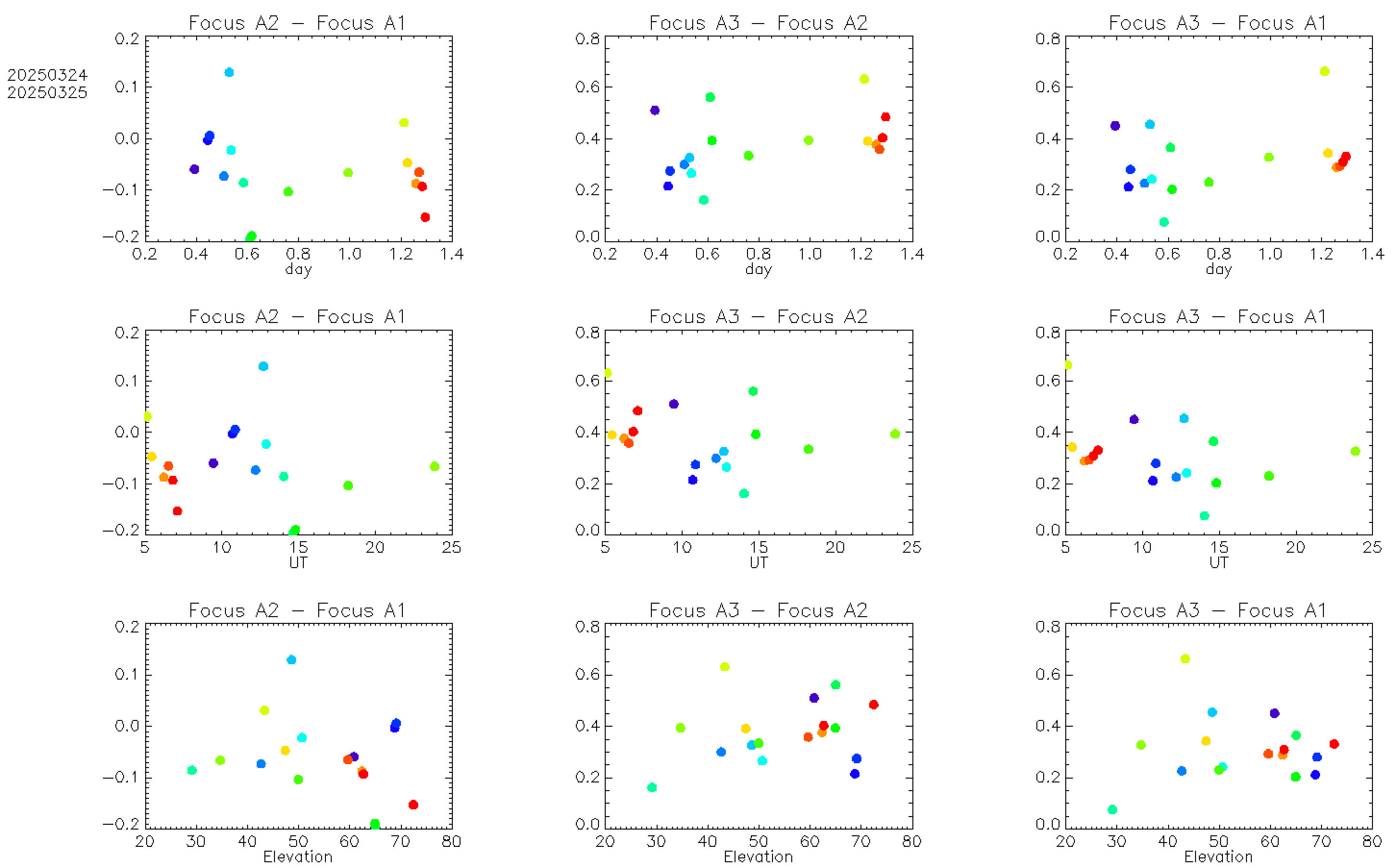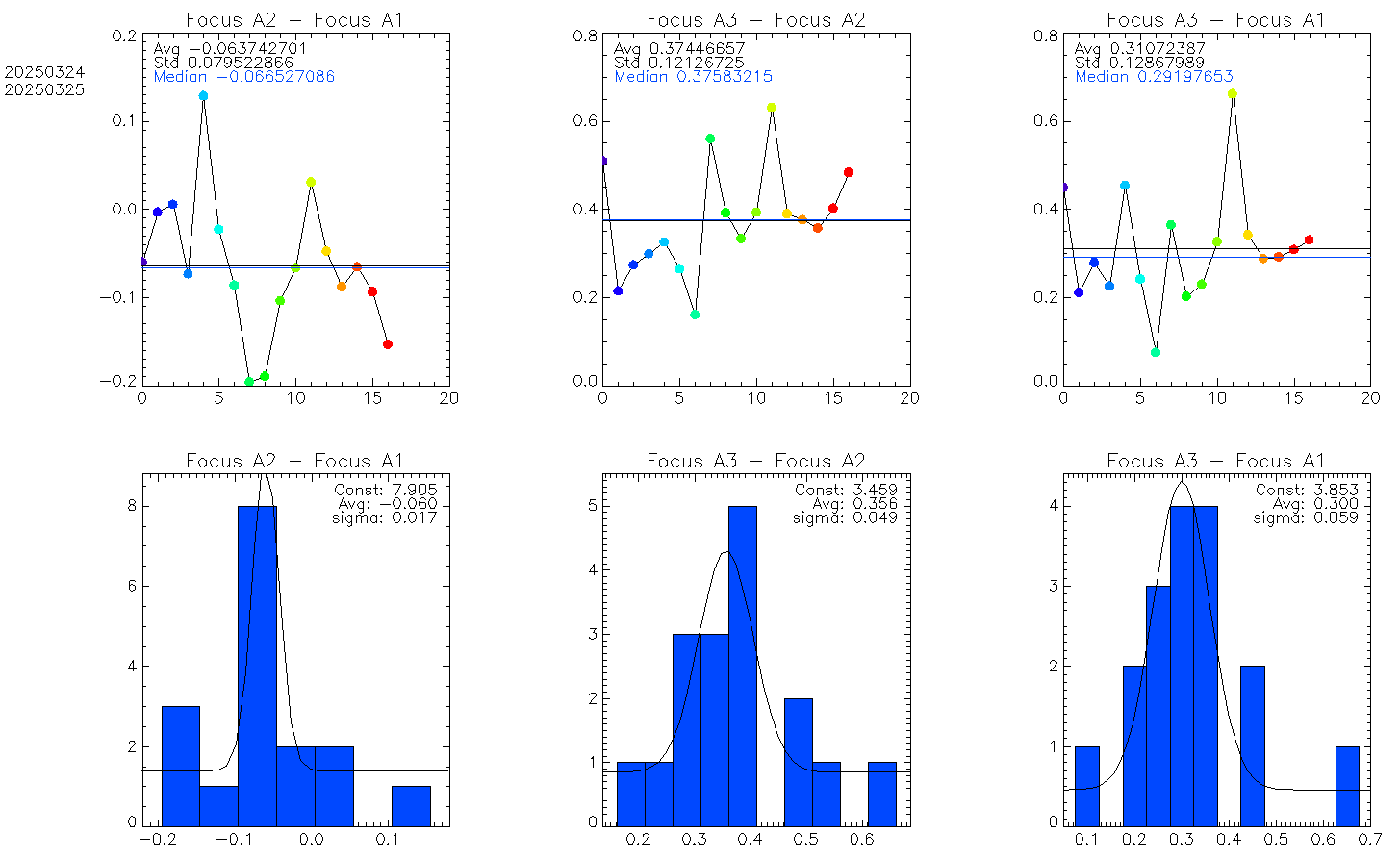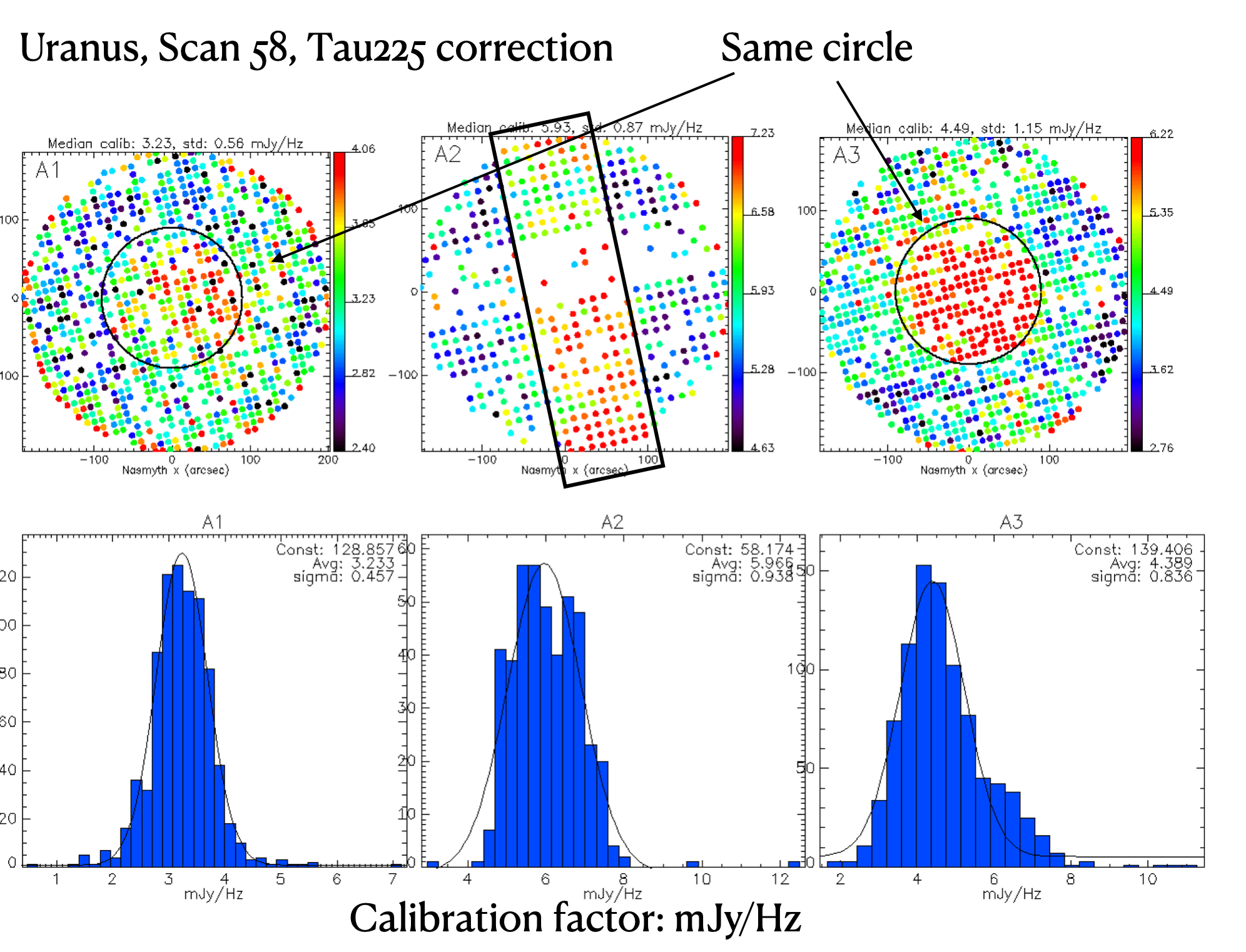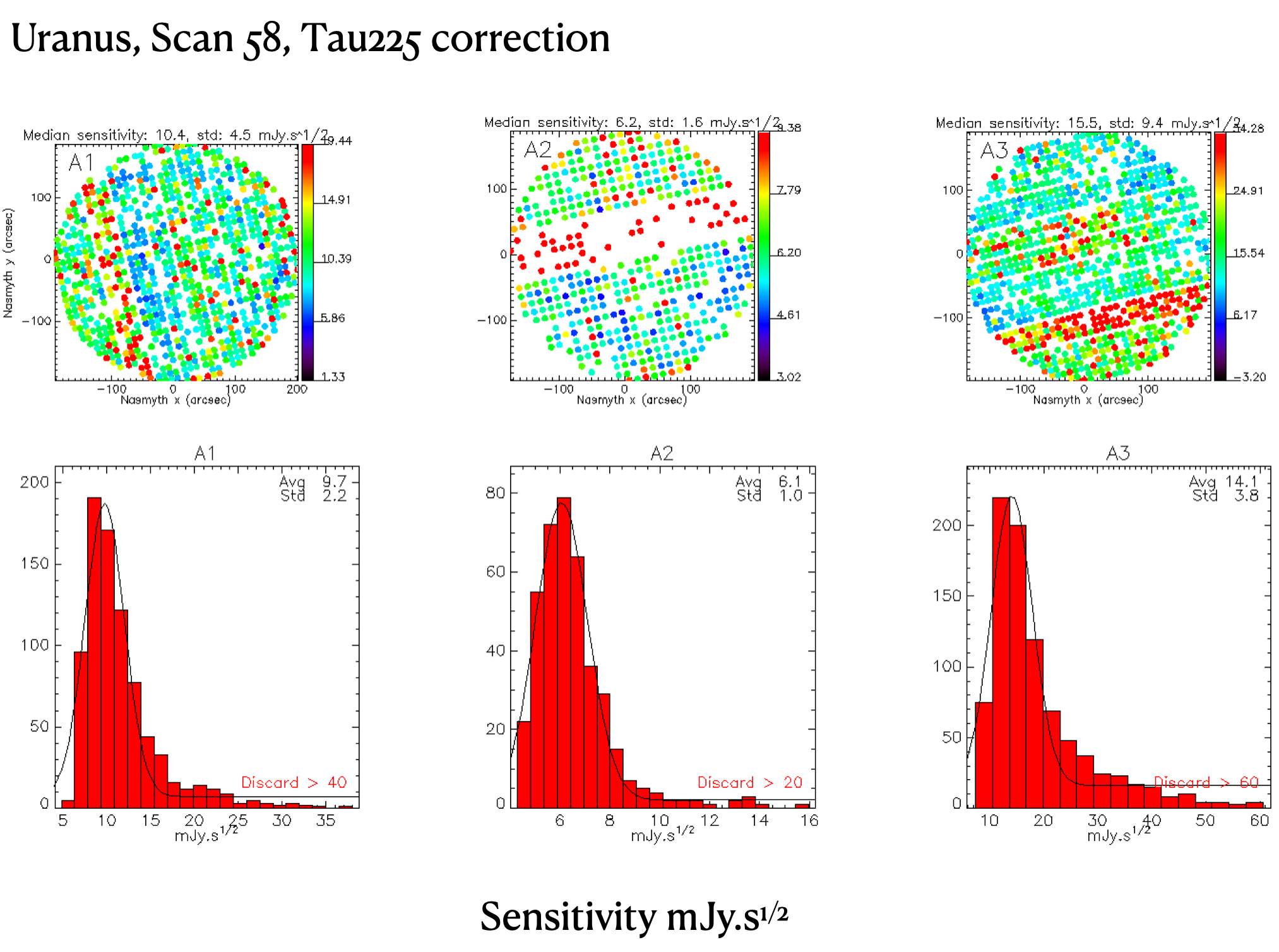Contents
NIKA2 Re-Commissioning
March 18th-25th, 2025 + ...
NIKA2 run 72
Cryo run 84
Tuesday, March 18th, 2025
@10:30 a.m. Angel, Carsten, Monica, Stefano and maaany others arrived at the Telescope. There is a lot of snow 2-3m or more, accumulated by the wind in some spots), the windows of the dining room are completely covered. The sky is cloudy, but it seems that it might clear up a bit later. No precipitation at the moment
In the morning we check the NIKA2 traces:
- Ar1 looks fine.
- Ar3 has a big noise bump at ~0.3 Hz, common to all KIDs
- Ar2 has noisy KIDS in Box C. There is also a noise peak at ~10 Hz for a number of KIDs and a new spike at 6 Hz for KID KA156.
We have a briefing to make the point of what needs to be done first.
- the make-imbf is ready to be started and used. Both new and old versions are set to the current commissioning run
- New sweep: done on Wed 12/3. Ar1 OK. Ar3 noise bump. A second sweep was done on Fri 14/3, adjusting the Ar3 one. It looks better. Ar2 has the original sweep, defined in October 2024.
- Radio alignment check. the weather is not good enough. Maybe on Thursday we will have a chance. At the beginning we will start the operations without checking the alignment. Meanwhile we'll ask Dave if he'd be available on Thursday.
- check DAQ on sky. This is the first operation we will do:
- Point a bright source (Mars, a QSO, or else, depending on the time of the day) and start an OTF
- Check traces to verify that we see the source
- check also the beam width on the traces
this will already tell us if a) we are on source; b) there are any problems with the dichroic and the beam
- small beam map: we will observe a small beam map (script already prepared by Nicolas and Angel), to be used by Nicolas to produce preliminary KIDPARS for the IDL pipeline
- with this, Nicolas will produce the first Kidpars.
- meanwhile we might observe already a first standard beam map for preliminary PIIC DAFs
- once the preliminary KIDPARS are ready, we proceed with pointing, focus, standard beam map, to be used to produce KIDPARS and DAFs for the whole array(s)
- with the big (standard) beam maps, Stefano will produce preliminary DAFs and Nicolas the KIDPARS
- once they're ready, we can start the PIIC Ql and we can give some peaceful time to Nicolas
- the standard beam map will give us already the followingnpieces of information:
- DAFs/KIDPARS
- flat field (i.e. is the dichroic healthy?)
- focus difference between the three arrays
- we'll then loop on pointing, focus, primary calibrators and calib_1scan, with the aim to collect enough statistics for:
- determine the new absolute flux calibration factors
- study the difference of focus between the three arrays
- derive new P2 and P7 values for the pointing model (Manuel might help with this)
We decide also that if we have dead times, there's no problem: we will avoid to put ourselves under pressure/stress and we will take the needed time to tackle possible problems/mistakes, discuss ideas and analyze the situation.
@13:15 LT: De-icing is switched on full power, but it's not fully working, there's some ice on the dish.
@15:25 LT: the Ar3 bump moved from 0.3 Hz to 0.6 Hz
@17:20 LT: it's still slightly snowing. Sometimes we see blu patches of sky. We check the main dish: it's mostly clean, except the upper-right rim and one of the four sub-reflectors supports. We park the antenna facing the "faint" sun, hoping it helps.
@19:00-19:30 LT: Frederic went up on the platform, but the ice on the legs of the subreflector is too hard and too far away to be reached and removed. Therefore we need to wait for the Sun to melt it tomorrow morning. Meanwhile the sky cleared up. Current air temperature: -4 C. Later the sky got foggy again.
Wednesday, March 19th, 2025
@07:00 LT: We wake up with a wonderful clear sky... and wind at 20-25 m/s. The current air temperture is -6 C. The telescope is facing the rising sun, in the hope that the ice melts, but the wind forecast predicts even stronger winds later today.
@10:00 LT: The wind has surpassed 32 m/s some time ago and some clouds are coming.
@12:30 LT: we have our first daily meeting.
- The weather is not collaborating, but we might have a chance tomorrow in the late morning and/or afternoon. Stay tuned!
- We developed a bad weather plan, in case we cannot go on the sky:
- PIMP: craning it up, installing it, running it. Samuel will send info on how to install it with photos. Dave will come to the telescope on Thursday and Friday to help with all steps.
- checks of the Ar3 synthetizer, Dave suggests to possibly replace it.
- Dave suggests tests of the radio alignment, even against a closed vertex.
- Since the Ar3 noise bump at 0.3-0.6 Hz is happening with the closed NIKA2 window, we think that it must be something vibrating inside the instrument or something about the Ar3 synthetiser, which may be much more sensitive than the previous Ar3. It could be the wind, though the previous Ar3 did not show this. In any case, this low frequency correlated noise should not affect observations.
Samuel points out that the constraints he set earlier for the check of the radio alignment (tau<0.2 and stability +/ 2 Jy/beam) can be relaxed. A tau up to 0.4 is fine, as long as we have stability.
- Samuel also suggests that - if we need to focus before the preliminary KIDPARS are ready - we could try to do it checking the traces and maximizing the signal of the source in there.
- priorities for tomorrow:
- if the weather permits, the 1st priority is go on sky
- if not, then we'll proceed with Dave's bad weather plan (see above)
- next meeting: tomorrow at 12:30 LT, using the IRAM-Granada video-cons system (check your email inbox)
Thursday, March 20th, 2025
During the night, we enjoy the wind show...
@08:00 LT: Current conditions: Temperature 0 C; wind speed ~20-30 m/s; sky partially cloudy. We now wait patiently for the wind to slow down further and give us a chance to start the NIKA2 operations.
@12:00 LT: Wind stays at 30-35 m/s. Transport cancelled. Based on input from SL, dedicated PIMP page created.
@12:30 LT: we have our daily meeting.
- observations cannot be started
the transport up here has been cancelled because the wind is >35 m/s
- tomorrow Dave will likely come up
- the plan is to use the PIMP tomorrow
- Samuel prepared a very good collection of all available pieces of information about how to install and operate the PIMP (thank you! See above). We'll try our best, but we won't get crazy to figure it out, in case we can't make it work in few hours.
- Angel will write to Martino, Alessandro, Juan et al. with some questions about PIMP details and with the current PIMP .ini file for verification.
- a big wind and snow storm are expected for tonight.
- therefore we cancel the next daily meetings. If we need help for the PIMP, we will actively contact you again.
Friday, March 21st, 2025
@09:00 LT: stopped. Wind meter frozen, but wind is probably still around 20 m/s. There is a lot of ice at the subreflector and in the lower part of the dish. Outside temperature -6deg. De-icing at full power. Low lying clouds above the telescope. AB tested the new ini file for acquisition with pimp.
@10:00 LT: Dave arriving. NIKA2 cooling ok, though 1 fan is stopped due to a block of ice.
@12:30 LT: PIMP work started:
- PIMP craned up.
AB & DJ mounted it.
@13:00 LT SB and CK join the PIMP work and we all test it together:
- scanning is ok;
- the DAQ needs to be switched on, in order for the connection to work (obviously);
- the connection to the acquisition is OK;
- the values of the parameters have been set to the values used in 2019: Cold black body at 30°, hot black body at 110°, PIMP control at 19200 bauds, Fmax at 892 GHz, resolution at 5 GHz, 10 subscans (1.36 minutes total duration), 112 steps/s, 1000 steps, limits: 0 to 78200.
- we notice that the data sampling frequency in the Raspberry is by default ~47 Hz, but we set the .ini file at ~23 Hz. Therefore, later we will double check what was in the 2019 .ini file and we will change to 47 Hz if needed.
- we have not yet positioned the PIMP in front of the NIKA2 window, but we start a couple of "fake" scans as a test. We would like to see where/if the scans are written. We think that - since the DAQ is on and the Raspberry/PIMP is connected to the NIKA2 net, this would produce some scan files. Instead, we do not find any new scan files written on disk.
- we will continue after lunch
Example of RFdIdQ vs. pimp_pos, one of the first tests done this morning. We were not aware of how to set the temperatures of the cold/hot loads properly, hence this was taken with both temperatures at ~19 C.
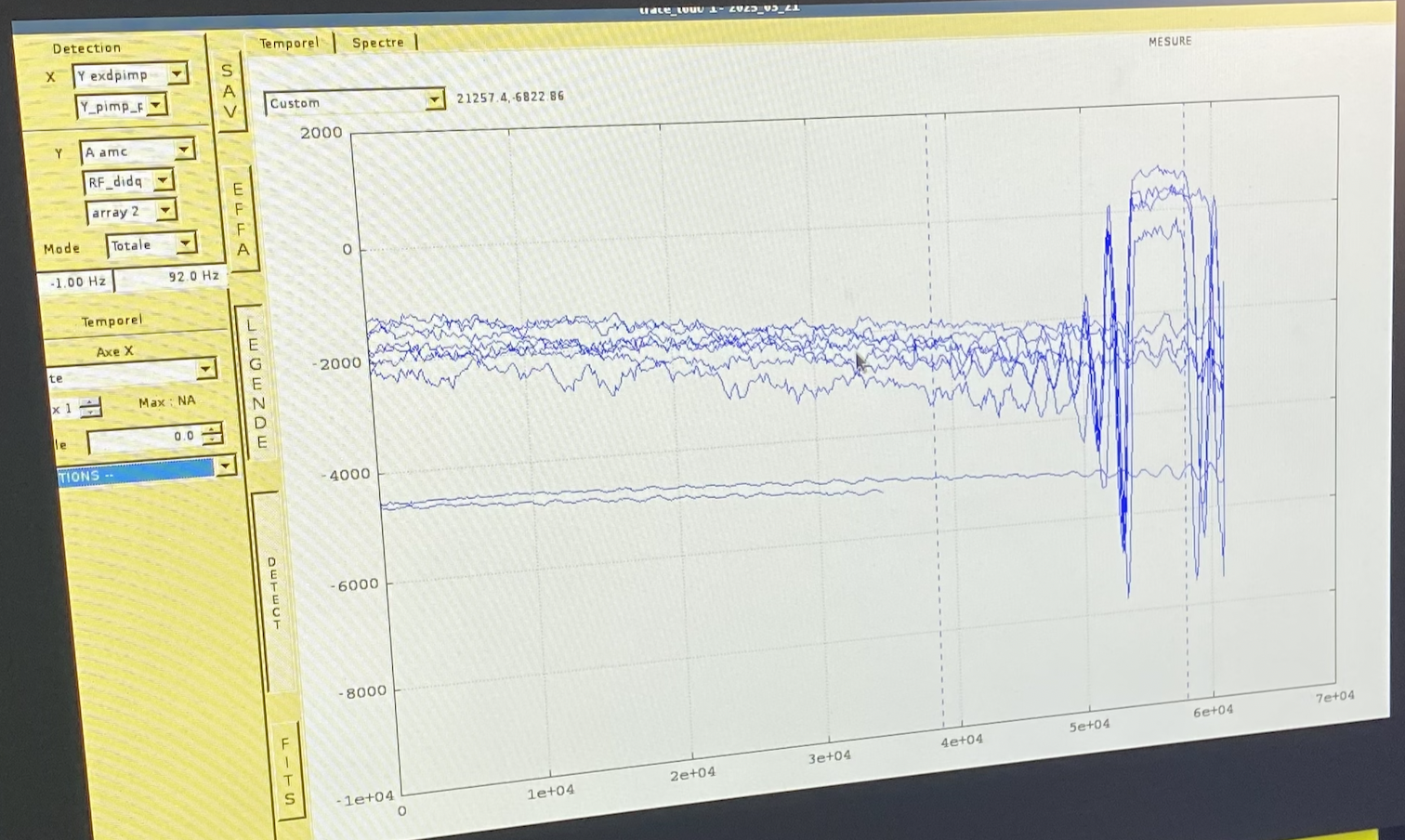
@14:30 LT: DJ & AB are working on exchanging the Ar3 synthesizer, but they interrupt because it requires more operations than expected.
@14:40 LT: we continue the PIMP work. Here follow a list of the important things we do and learn. This can be used as a "practical guide" to use the PIMP in the future, and a condensed shortlist has been copied to the dedicated PIMP IRAM-ES wiki page:
the PIMP has already been mounted and tested before lunch (see above). We followed the instructions given by Samuel. These instructions can be found here.
- we manage to install the PIMP in front of the NIKA2 window. Unfortunately it touches on one side the support of one of the mirrors and on the other side the cryostat, when changing the PIMP orientation angle. It did not touch in 2019, but now it does. Dave slightly smooths the PIMP corner at the side of the wall/mirror, and it goes through.
- we switch on the electronics "grey box" and the Raspberry
- the temperature of the cold and hot loads must be set on the grey box. This is done by selecting the cold or hot load (with the dedicated analog switch), and increasing their voltage. The current temperature is displayed on the grey box. We start at ~19 C for both. It takes roughly 15 minutes to reach 30 C for the cold load and at least 1 hour to reach 110 C for the hot load. These values are those used in 2019. NOTE that it's not sufficient to set the numbers in the Raspberry (as we thought this morning), but it's necessary to set the heaters properly on the grey box.
- set up the parameters of the Raspberry (see what we did before lunch). Now it's important to point out that the temperatures come from the grey box and need to be set (copied) by hand in (to) the Raspberry;
- also the current tilt angle needs to be set by hand (bottom yellow "tilt angle" button): it represents the physical orientation angle of the PIMP.
- note that the max Frequency we choose was 892 GHz, but it might have a limit lower than that. For example, it seems to be 889 or 891 GHz, depending on some other setup.
- the PIMP communicates properly with the DAQ: we start a scan by clicking on the Raspberry "Scan" big button. We examine the traces on the DAQ (pimp_pos on the x axis, RFdIdQ on the y axis) and we clearly see the PIMP signal
nevertheless, the scan files are not written automatically. Martino explained us how to manually start the recording of a scan on file (thank you!): click on the big black rectangle in the lower part of the small "file" window (usually on the same window where DAQ is launched); this creates a new file, of "manual" kind; the file name appears in that same box, and the box is now colored pink; stop the recording by clicking again on the same rectangle.
@16:00-17:00 LT we are almost ready to start the PIMP integrations. Only the hot load temperature needs to reach 110 C. Meanwhile we take some test scans, to verify that the files are now correctly written, using the manual procedure. And here start some problems:
- we suddenly lose the tuning of Ar1 and Ar3, during the first integration
- we re-tune and recover Ar1 and Ar3, but Ar3 has now 60 lost KIDs. Uhm, this seems a large number. It was much smaller before.
- we re-tune and Ar3 is gradually losing increasingly more KIDs. We re-tune again and again, trying to recover Ar3, but...the number of KIDs lost increases: first 60, then 180, then 640, and finally 848 after half an hour or more trying.
- we try to switch the light off, in the hope that it had some influence, but there's no improvement
- we decide to go only with Ar2 and Ar1 and proceed with the PIMP measurements anyway
@17:20 LT it's time to go on
- also Ar1 and Ar2 are losing KIDs, evidently it's the effect of the high PIMP temperature. It's time to integrate
- after reaching the nominal temperature, the voltage of the heaters needs to be decreased, so to keep the temperature stable, namely:
- full power when heating
- ~2.5 Volts for the cold load will keep it at roughly stable T~31C
- ~29 V for the hot load at T~108C
- at each change of angle the tuning of Ar1 and Ar3 is lost (polarized arrays) and we re-tune
- we have to limit to an angle of +15 deg max, because - beyond this - the PIMP box touches the cryostat
Summary of scan file names (in the run84_X/X36_2025_03_21/ directory):
Scan nr
Filename
Tilt angle
Optics
Notes
10
16:23:47
0
Divergent
11
16:26:16
0
idem
12
16:31:28
-90
idem
re-tuned
13
16:34:23
-90
idem
14
16:41:03
-45
idem
re-tuned
15
16:42:50
-45
idem
16
16:48:57
+15
idem
re-tuned, angle at the limit of touching the cryostat
17
16:50:44
+15
idem
@17:55 LT: the NIKA2 window cover is back in place. We give it some time and then we'll check the tuning again, to see if the KIDs will be back. And @18:10 they're all back, all three Arrays, with lost KIDS: 11/13/11 (Ar1,2,3). It seems that the PIMP (hot) load was too hot (we used ~110 C as recommended).
We did not find the convergent lens.
Synthesizer exchanged. However, there is no effect on the power spectra.
Saturday, March 22nd, 2025
@09:40 LT: Stopped. blue sky, low wind. But there is a lot of ice in the dish and it is -10deg. Pointing towards the sun.
@10:00 LT: Changed back to old synthesizer. One of the two NIKA2 fans starts hitting ice. Difficult to access due to risk of ice fall.
@10:40 LT: PIMP restarted. Checking black-bodies temperature settings for the PIMP. Today we keep the hot load colder (~50 C) than yesterday (~110 C). DAQ restarted; bad KIDs: 70/953, 8/578, 24/1000 (look better than yesterday). Today's data are in the run84_X/X36_2025_03_22/ directory. Here's a summary of the scans we took:
Scan nr
Filename
Tilt angle
Optics
Cold_T
Hot_T
Notes
18
09:51:29
0
Divergent
28
68
could be incomplete
19
09:52:38
0
Divergent
19
79
central feature of the interference pattern in the dIdQ vs. pimp_pos is flatty (is it right?)
20
09:57:32
0
Divergent
19
78
21
10:04:32
0
Divergent
18
68
22
10:07:26
0
Divergent
18
68
23
10:15:34
0
Divergent
20
58
24
10:23:13
0
Divergent
23
58
Temperature readings in the grey box are not so stable
25
10:27:45
0
Divergent
25
53
26
10:32:53
0
Divergent
27
53
27
10:38:11
0
Divergent
31
51
28
10:44:27
-45
Divergent
34
51
clock-wise; re-tuned
29
10:46:34
-45
Divergent
34
51
30
10:50:50
-90
Divergent
34
51
clock-wise, re-tuned, 36/10/388 KIDs lost (Ar1,2,3); be careful: tilt angle wrong in the header
31
10:54:02
-90
Divergent
34
51
be careful: tilt angle wrong in the header
32
11:00:03
+15
Divergent
34
51
ccw; re-tuned; 248/15/225 lost KIDs (Ar1,2,3)
34
11:54:15
0
Divergent
34
51
Coming back after BB temps. stabilisation. Re-tuned, 74/12/21 KIDs lost (Ar1,2,3)
35
12:01:08
0
Divergent
34
51
36
12:06:38
0
Divergent
34
51
37
12:21:43
-90
Divergent
34
51
Tuning lost, re-tuning: 329/11/340 lost KIDs (Ar1,2,3)
One example of today's PIMP signal (RFdIdQ vs. pimp_pos):
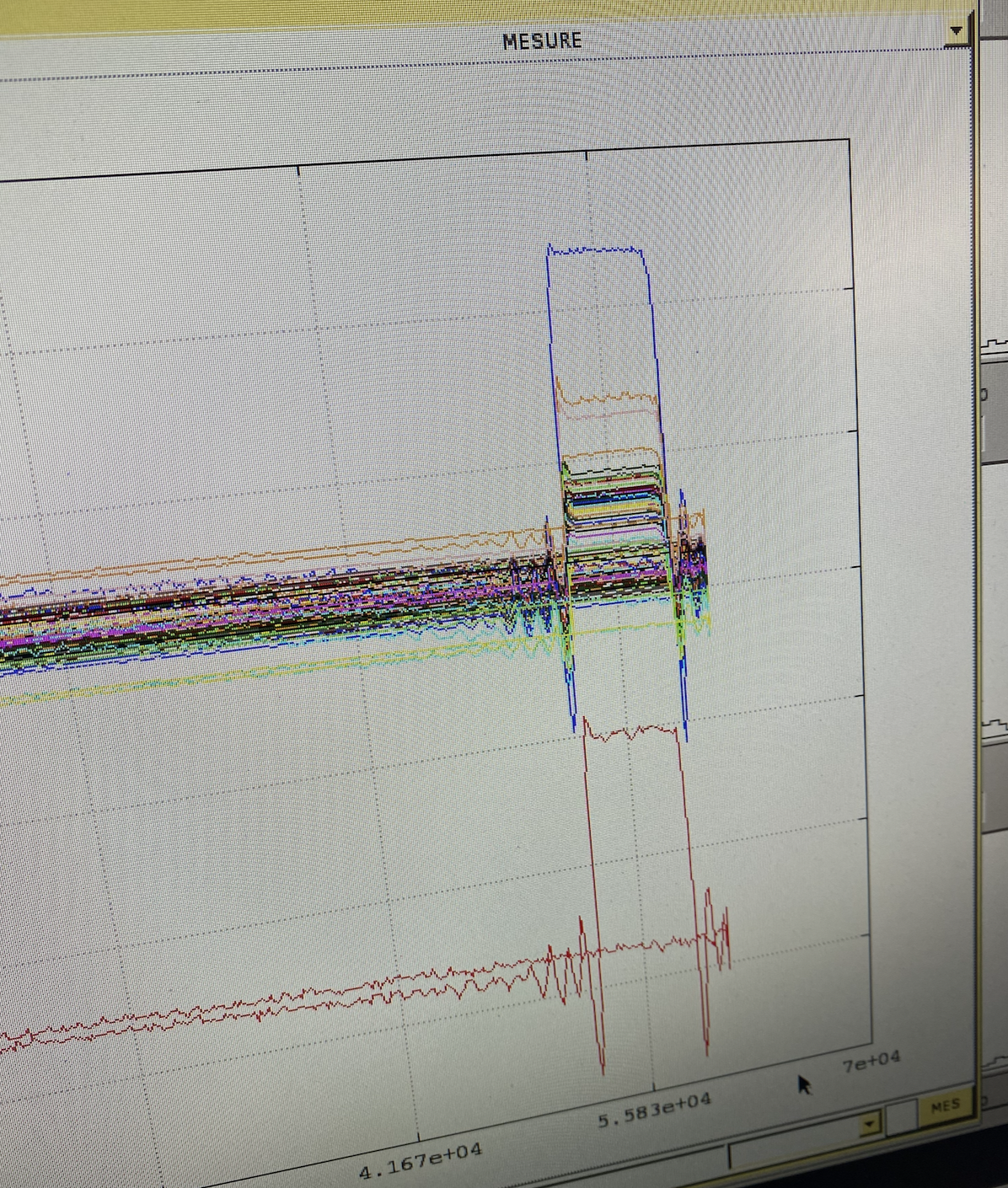
@15:00 LT: after talking with Juan, we do it again, switching the auto-tune OFF! Nevertheless, we don't solve the problem of the "plateau" at the peak signal. It takes another 2 hours, with the online live support of Juan and Andrea, to figure it out. Basically, the problem was that the moving mirror was not going all the way to 78200 steps (39 mm) as designated, but it was stopping (and coming back) at 61000 (30 mm). The illuminating point was the suggetsion by Andrea and Juan to try to "go a bit further" or move the fixed mirror - or the polarizer - by at least ~1 cm. The solution was to change the frequency resolution from 5 GHz to 3.85 GHz. Therefore, now, the best set of parameters values is:
Parameter
Value
Homing speed
112 step/s = 4.464 mm/s
Sampling freq
46.4 Hz
Zero path
100 steps = 0.05 mm
min lim
0 steps = -0.5 mm
max lim
78200 = 38.6 mm
Short step
1000 = 0.5 mm
Initial speed
119 step/s = 0.059 mm/s
Initial acc
255 step/s2 = 0.128 mm/s2
Fmax
892 GHz -> 891 GHz
resolution
3.9 GHz !!
corresponding range
-0.5 to 38.5 mm
nr subscans
20
duration
3m46s
List of scans (run84_X/X36_2025_03_22/X_2025_03_22_*_AA_man )
Scan nr
* file name
angle
lens
T(cold)
T(hot)
Notes
76
16h27m05
0
Divergent
20
59
re-tuned: 97/11/22 lost KIDs (Ar1,2,3)
77
16h31m18
0
Divergent
20
59
78
16h34m58
0
Divergent
20
59
79
16h44m06
-45
Divergent
20
59
re-tuned: 25/10/153 lost KIDs (Ar1,2,3)
80
16h48m11
-45
Divergent
20
59
81
16h54m27
-90
Divergent
20
59
re-tuned: 5/13/400 lost KIDs (Ar1,2,3); telescope moving in Az (vibrations)
82
17h00m20
-90
Divergent
20
59
re-tuned: 3/13/199 lost KIDs (Ar1,2,3)
83
17h04m35
-90
Divergent
20
59
84
17h14m30
-60
Divergent
20
59
re-tuned: 5/13/139 lost KIDs (Ar1,2,3)
85
17h18m46
-60
Divergent
20
59
86
17h25m36
-30
Divergent
20
59
re-tuned: 35/9/89 lost KIDs (Ar1,2,3)
87
17h30m28
-30
Divergent
20
59
88
17h38m19
+15
Divergent
20
59
re-tuned: 63/10/67 lost KIDs (Ar1,2,3)
89
17h42m32
+15
Divergent
20
59
90
17h48m37
+15
Divergent
20
59
re-tuned: 62/10/72 lost KIDs (Ar1,2,3); testing auto-tune ON
The last scan (nr. 90) is a test to see the effect of the auto-tune switched ON. Result: on the Ar2 traces no obvious difference is seen with respect to the scans with the auto-tune switched OFF.
Examples for Ar2 vs sample (left) and vs pimp_pos (right):

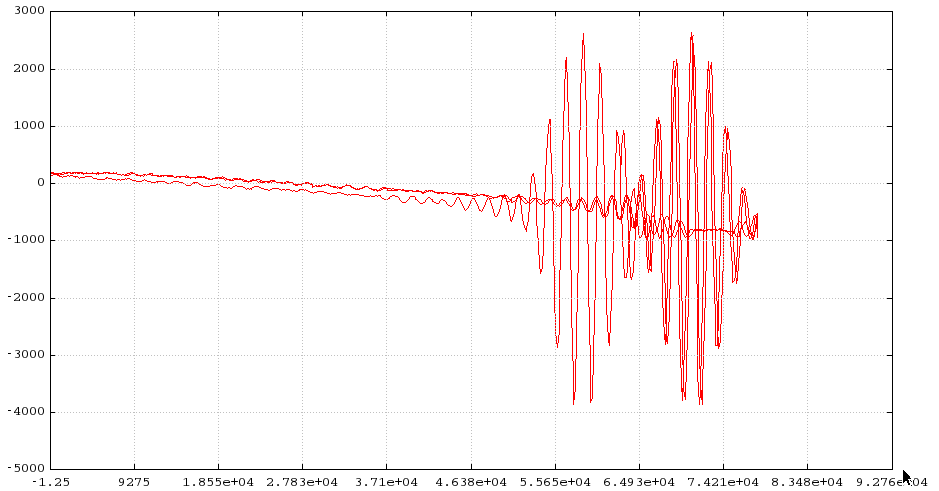
Example for Ar3 vs sample (left) and bonus image of today (right):
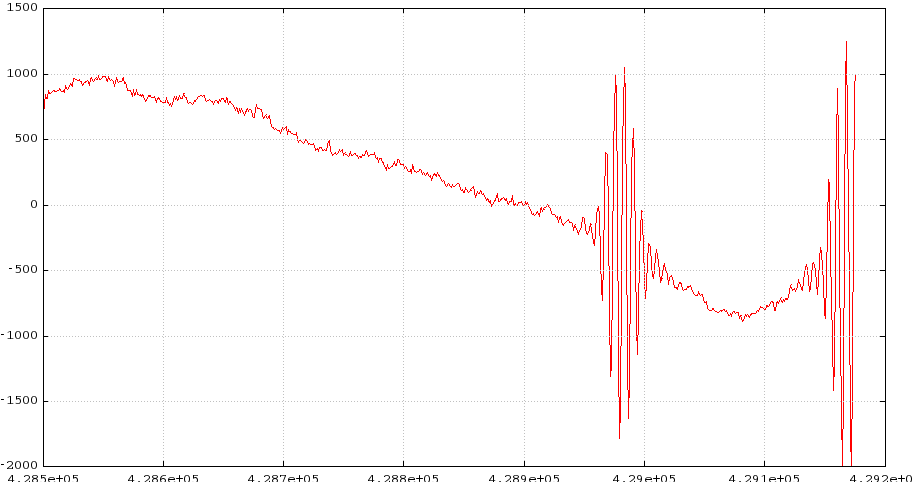
Fast (and dirty) spectral analysis of scan 77


Sunday, March 23rd, 2025
@09:30 LT: Still stopped, like every other day since we arrived. Snowing, foggy, -7deg.
@11:00 LT: Angel found the convergent lens of the PIMP. It was located 2 m away from the PIMP box, in a bubble wrap, with no labels whatsoever, on top of a pile of random cartoon boxes. Perfect! Than you Angel for your sharp eye! Now we mount it and re-do the PIMP story once again with this convergent lens. Note that the divergent lens is much thicker at the edge than the convergent one, therefore the screws that hold it are too long for the convergent lens (SB: no comment). Dave retrieves shorted screws. We adopt the same parameters as yesterday (see above for details).
SB thanks personally Dave for spending the weekend with us in the snow storm(s), instead of enjoying a warm sunshine down in Granada.
List of scans (run84_X/X36_2025_03_23/X_2025_03_23_*_AA_man )
Scan nr
* file name
angle
lens
T(cold)
T(hot)
Notes
91
11h07m05
0
Convergent
19
60
re-tuned: 112/10/30 lost KIDs (Ar1,2,3)
92
11h14m32
-30
Convergent
19
60
re-tuned: 53/11/65 lost KIDs (Ar1,2,3)
93
11h21m05
-45
Convergent
19
60
re-tuned: 37/10/90 lost KIDs (Ar1,2,3)
96
11h30m23
-60
Convergent
19
60
re-tuned: 36/10/129 lost KIDs (Ar1,2,3)
97
11h36m46
-90
Convergent
19
60
re-tuned: 28/10/196 lost KIDs (Ar1,2,3)
98
11h43m22
+15
Convergent
19
60
re-tuned: 70/13/119 lost KIDs (Ar1,2,3)
@ 13:00 LT: PIMP has been de-installed, packed, and craned down again. With some more experience, the PIMP page has been updated.
@ 17:00 LT: Still stopped: windy, foggy, snowing.
@ 19:45 LT: Before craning down the PIMP, Dave closed the NIKA2 window and shielded its borders with aluminum tape. Switched to run84_tp.ini file. DAQ restarted and re-tuned: 7/953, 16/578, 9/1000 KIDs lost (Ar1,2,3). Screenshots below show the monitor and bottom-line noise traces at this time:
@21:30 LT: we start the new and old make-imbf, just in case there will be a chance to go on sky during the night (so we don't have to start it at 3 a.m.)
Monday, March 24th, 2025
@ 03:30 LT: Midnight snowfall was quite intense. Frédéric removed as much ice as he could from the legs and the sub-reflector cell. Thanks, Frédéric! But a couple of large ice sticks in the upper outer rim/layers on the lower part of M1 prevent the operations. Likewise, hard ice patches in the central part of M2 are also reported. The de-icing is still on, but the effect of the sun will be essential to have the telescope in good shape. Waiting for mid-morning.
@ 08:30 LT: Telescope oriented to the Sun position, 0 deg. elevation, for contributing to the de-icing. Switching off the telescope's de-icing system. Vertex cannot be opened (hinges are probably frozen).
@ 09:40 LT: After sunlight exposition, the telescope is under minimal conditions for starting observations (a thin layer of ice in the lower part of M1 remains at the beginning). Vertex opening system works properly. Moving the telescope close to 2251+158. DAQ restarted and re-tuned: 4/953, 16/578, 9/1000 KIDs lost. Nicolas Ponthieu joins us through skype. Adopting previous DAFs of array 2 for quick-look reduction using PIIC.
The first surprise of the morning was the absence of data from box C (array 2) after the first pointing and focus scans. See the results from PIIC and IDL for (e.g.) scan 20250324s35 in the screenshots below:
Several hypotheses are being managed. Firstly, DAQ was restarted twice and a hard reset of the Ar2 electronics was done. There is a suspicion that some KIDs of box C are noisier than expected, for any unknown reason so far. Stefano and Nicolas are editing the corresponding rejection thresholds -provisionally- in the KIDs signal in the PIIC and IDL-RTA codes, respectively, with the intention of recovering as many of them as possible in box C. Preliminary DAFs and KidPars are in progress.
Before the daily meeting, a partial beam map (scan 20250324s22; 25 scans) and two full beam maps (s23 and s37) were obtained, all of them on 2251+158. Beam shape was improving quickly since the beginning of the observations, getting a FWHM ~ 17.46" x 18.32" about 2.5 hours after the beginning of the observations.
@ 12:30 LT: Daily meeting (MR, SB, CK, DJ, IM, SA, SL, AS, AM, MS, AB). Updating about re-commissioning progress since last Friday. AM asked for obtaining some timelines for each array during scans on (e.g.) a planet.
@ 13:00 LT: Moving to Uranus when El. ~40 deg. From focus sequences, beam geometry is improving clearly. The screenshots below show the timelines of focus scans on Uranus per arrays 2 (box C), 1 and 3:
Note by SL: For A2 it seems you have plotted KIDs from box C which has a problem as you mentioned previously, so this is not representative of how the signal is for the boxes which don't have problem... Could you display the timelines of another box?
Getting skydips (s44, s99) and a full beam map (on-focus) on Uranus (s58).
@ 14:35 LT: Starting a calib_1scan session: Uranus (s61), MWC349 (s68), CRL2688 (s69), NGC7027 (s70), W3OH (s82)
@ 16:00 LT: Becoming cloudy. Last pointing corrections tell us about possible anomalous refraction in the l.o.s. Inside the cloud at 16:10 (LT). Observations stopped.
@ 17:30 LT: quick update on the preparation of the PIIC DAFs by SB:
- the Ar2 has the same sweep as in runs 68 to 71
- Ar1 and Ar3 are new and therefore have a new sweep
- Ar2 box is problematic. PIIC flags it in most pointi/focus scans. The reason is yet to be understood. Box C includes the pointing pixel (i.e. the reference KID)
- we have three beam maps: 20250324s23,37 and 58 (2251+158, 2251+158, Uranus). Scan 23 is bad, but the KID adjacent to the old pointing KID is not flagged. Scan 37 is terrible (froget it). Scan 58 is the best of the three, so far: most of the box C KIDs are not flagged, but the old reference KID is. For now, I chose as reference the KID adjacent to the left of the old one (old one: 363=KC016, new one 355=KC009, in PIIC numbering and Ar2 KID "names").
- Ar1 and Ar3 look healthy
- note that changing the reference KID, the pointing offsets change! Therefore we should use the same reference in IDL and PIIC, so to have a good match and data reduction with both.
- I'm waiting to complete the analysis to be more conclusive and post some plots
While processing the beam maps with PIIC, it happened that the "new" imbf have a number of record couples with the same time. Jean has been notified. Meanwhile the imbf produced by the old make-imbf are being used.
List of KIDs numbering correspondences:
KID-ID (NIKA2 run 72 .ini) |
NAME |
Array |
PIIC (run 68 sweep) |
PIIC (run 72 sweep) |
NOtes |
821 |
KC016 |
2 |
363 |
363 |
OLD reference KID |
813 |
KC009 |
2 |
355 |
355 |
Temp used by Stefano but failed on Ar1 and Ar3 w/ segm. fault! |
416 |
KB013 |
2 |
202 |
202 |
Temp used by Stefano |
6083 |
KP004 |
3 |
520 |
425 |
Temp used by Nicolas |
@ 18:35 LT: Resuming observations. DAQ restarted and re-tuned: 9/953, 13/578, 22/1000 KIDs lost.
The screenshots below show a new set of timelines from focus scans on Mars per arrays 2 (box B), 1 (box H), and 3 (box Q):
@20:00 LT: the POLAMI group of Ivan Agudo takes over, for 4 hours of POLAMI observations,.
@20:30 LT: we welcome back our old good friends, the Spindle / Hexapod Errors.. this time with some extra twist that complicate the recovery (Frederic et al. are working on it). We did not miss you!
@22:00 LT: after fighting with Box C, NIKA2 and PIIC for the whole day, Stefano finally converges to a preliminary PIIC analysis of the beam-maps. Sorry for the delay: I re-did it N times, seeking different solutions for the reference KID and trying different tricks to solve the missing KID 363, but without success. Therefore now the preliminary version is based on KID 202 of Ar2 (see table above). The best beam map so far is scan 20250324s58, in my opinion. To be improved in the +/- near future with new data.
Here follow some plots that visualize the current status of the arrays, via the beam-maps analysis.
IDL results by Nicolas (thank you!), based on beam map 20250324s58:

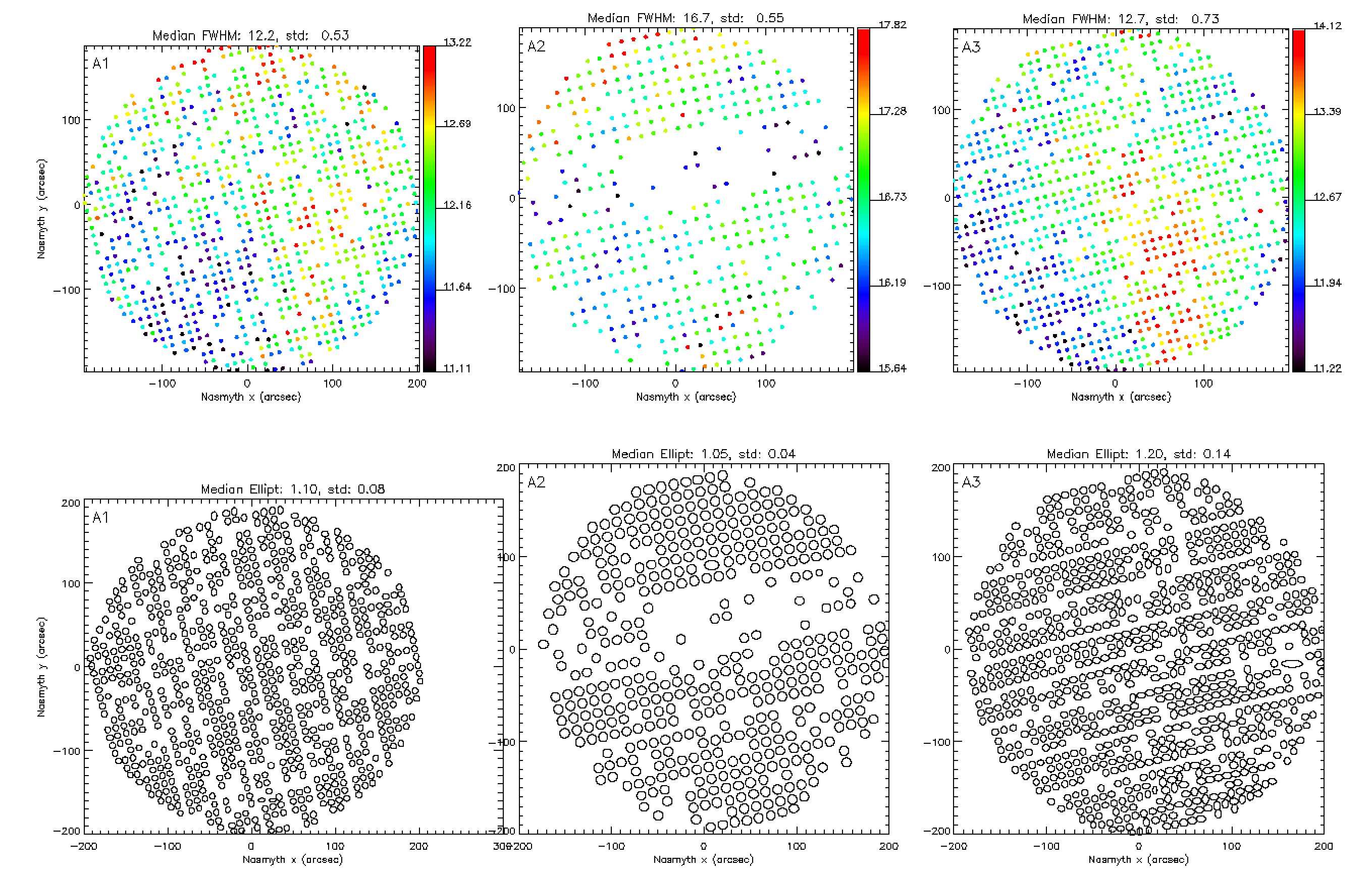
PIIC results by Stefano, based on beam map 20250324s58:


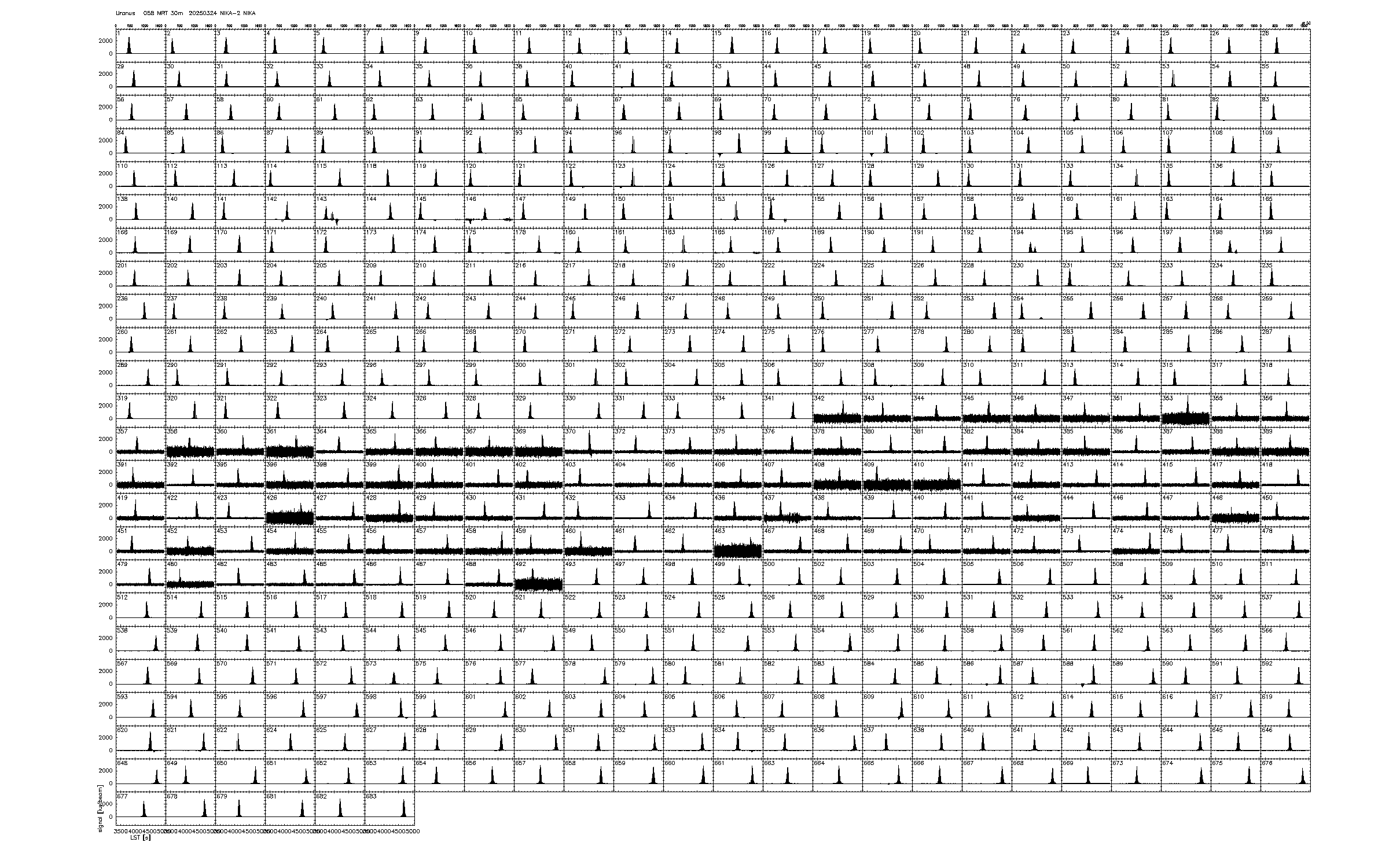





Note that in the reduction/analysis of beam maps the Ar2 Box C is (much) more populated than in the on the fly reduction of pointing/focus/maps scans. This is because of different thresholds (values/types) adopted in the different kinds of data reduction. The reference KID (363 Ar2) is rejected by PIIC because of very low (bad) flat field correction and also because of very low correlation coefficient. This happens likely because of the enhanced noise of Ar2 Box C.
As a comparison, the flat fields given by Perotto et al. 2020 are shown here:
Moreover, when reducing the pointing/focus or calib_1scan maps on the fly with PIIC, we noticed that Ar2 Box C is rejected systematically, but when the noise of the timelines is very high, few KIDs of Box C are retained. This likely happens because the rejection is done based on the noise of the given KID vs. the median noise of the whole array. Here follow a couple of examples: scans 20250324s7 and s103 (focus the attention on the top-right panel).

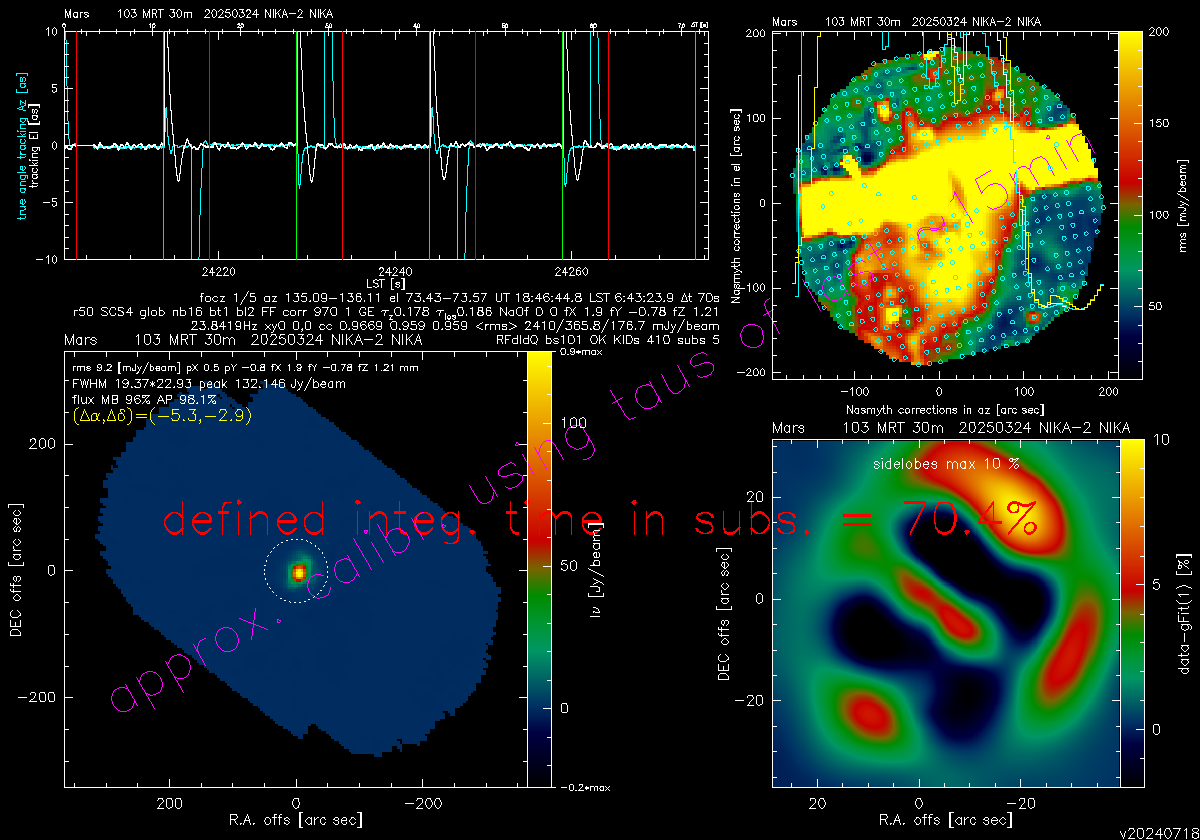
Despite the fact that the beams did not look so nice today (especially at 1mm, likely due to bad sky conditions, but we cannot exclude some bad optics effects at this stage), here come some focus statistics (20250324s...), to be taked with a lot of grains of salt (approximative values, plus some targets are intrinsically extended). [NOTE: I later added also the 2025/03/25 (better) scans.]
2025/03/24 |
2025/03/25 |
||||||||
scans |
target |
Ar2 |
Ar1 |
Ar3 |
scans |
target |
Ar2 |
Ar1 |
Ar3 |
6-10 |
2251+158 |
bad |
bad |
bad |
6-10 |
1253-055 |
1.30 |
1.28 |
1.55 |
11-15 |
2251+158 |
2.18 |
bad |
bad |
13-17 |
MWC349 |
1.32 |
1.30 |
1.60 |
16-20 |
2251+158 |
2.50 |
2.55 |
2.72 |
21-25 |
NGC7027 |
1.25 |
1.25 |
1.52 |
24-28 |
2251+158 |
2.00 |
- |
2.20 |
28-32 |
K3-50A |
1.34 |
1.29 |
1.64 |
29-33 |
2251+158 |
1.90 |
- |
2.15 |
35-39 |
CRL2688 |
1.29 |
1.30 |
1.56 |
39-43 |
Uranus |
1.35 |
- |
- |
42-46 |
MWC349 |
1.25 |
1.24 |
1.50 |
47-51 |
Uranus |
1.10 |
- |
- |
49-53 |
CRL2688 |
1.28 |
1.30 |
>1.70 |
52-56 |
Uranus |
1.10 |
- |
- |
56-60 |
NGC7027 |
1.40 |
1.35 |
>1.70 |
63-67 |
MWC349 |
0.80 |
0.83 |
0.95 |
63-67 |
K3-50A |
1.30 |
1.33 |
1.53 |
72-76 |
W3OH |
0.95 |
1.00 |
1.10 |
71-75 |
MWC349 |
1.36 |
1.45 |
1.75 |
77-81 |
W3OH |
0.80 |
1.05 |
bad |
78-82 |
CRL2688 |
1.35 |
1.41 |
>1.70 |
88-92 |
Uranus |
1.20 |
- |
- |
85-89 |
NGC7027 |
1.47 |
1.53 |
>1.70 |
93-97 |
Uranus |
1.25 |
- |
- |
92-96 |
MWC349 |
1.55 |
1.63 |
1.90 |
103-107 |
Mars |
1.30 |
1.51 |
1.60 |
112-116 |
W3OH |
bad |
bad |
bad |
150-154 |
Mars |
1.40 |
1.45 |
1.53 |
117-121 |
W3OH |
1.25 |
1.26 |
1.49 |
156-160 |
Mars |
1.30 |
1.30 |
1.50 |
|||||
Tuesday, March 25th, 2025
@00:00 LT: we restart the NIKA2 observations. Lost KIDs: 4/8/19
A nice example of focus (the best so far, scan 156):


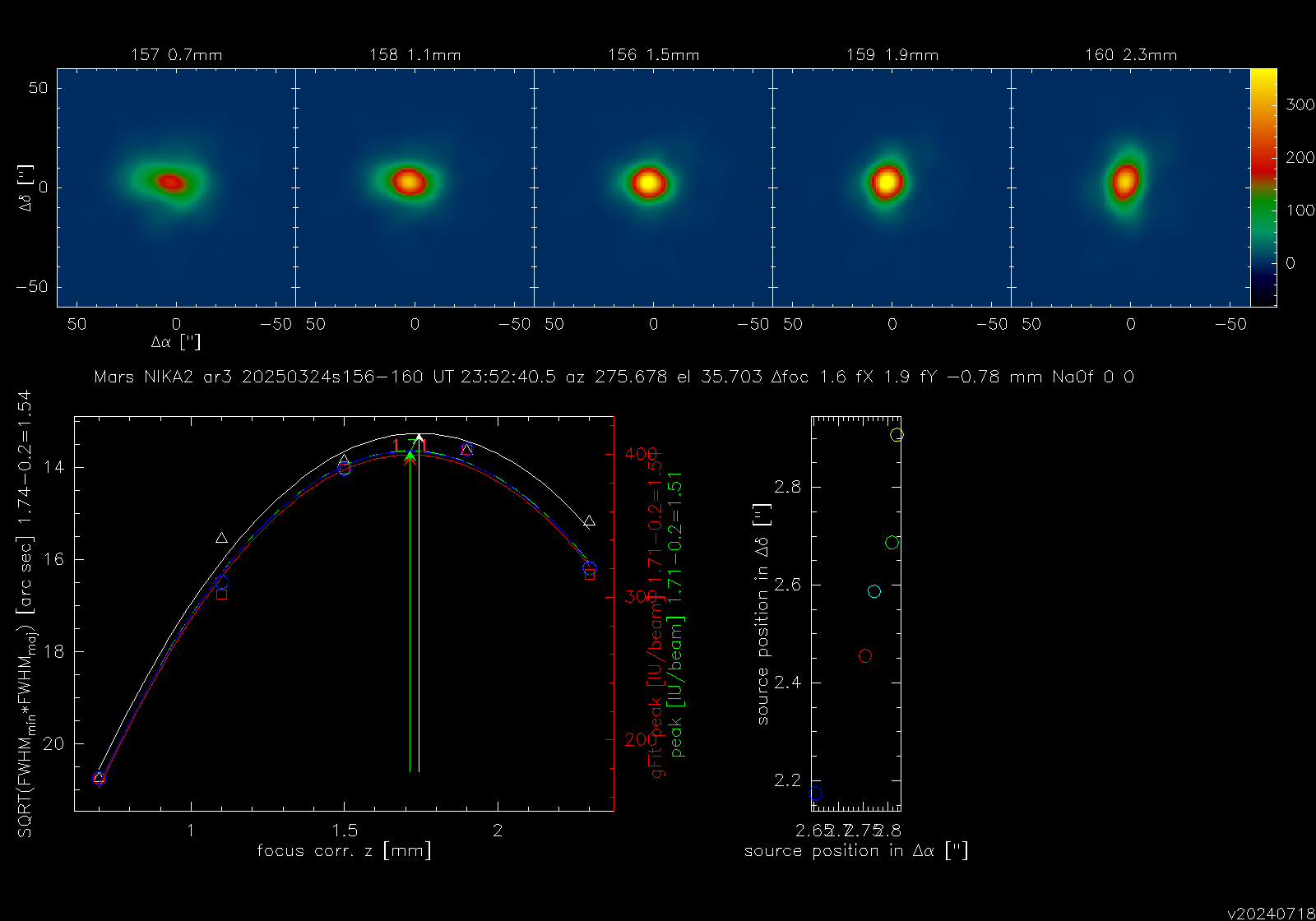
@01:00 LT. Lost KIDs 15/11/54 on the DAQ
@01:20 LT we try to work on the electronics:
- we swap the in/out cables of boxes C and D. Not a good idea.
we change the board of Box C with a spare (board 12 -> 17). Note that now the IP is 169 instead of the old 164. Result: the KIDs of Ar2 Box C are still rejected by the data reduction (scan nr 20250325s4). This demonstrates (we think) that the warm electronics is not the issue that affects the Box C of Ar2. Sigh.
- we put back the original board 12 (IP 164)
- @03:20 LT NIKA2 is tuned again (4/11/24 KIDS lost) and we're back observing: scan 20250325s5; nothing changed.
@03:20 Wonderful sky, we continue looping on pointing/focus/calibrators
@03:40 LT: Beammap on 1253-055 (scan 20250325s11). Very stable conditions: +-1Jy. tau225~0.23.
@04:40 LT: pointing, focus, calib_1scan on MWC349 (3 calib_1scans: 19,47,76), NGC7027 (3 calib_1scans; 26,61,90), K3-50A (2 calib_1scans; 33,69), CRL2688 (3 calib_1scans; 40,54,83).
@08:19 LT: Telescope alarm activated; hexapod error (Hxp limit XY triggered, according to the ACU prompter; it happens for the second time in ~12h as far as there is news). Stopped. Trying to recover the telescope. Enrique Lobato and Manuel Nieto (TG) are working on that.
@10:00 LT: After several tries, we continue with the problem. Trying again on W3OH. Pointing & focus okay. Then, a calib_1scan. Week finished.
@12:00-16:00 LT: Nicolas: Early analysis of March 24th and 25th focus sequences (IDL):
- Many kids are missing in the center of A2, so it's possible that the focus that we derive here is biased by the kids on the edges of the focal plane. It's not the case for A1 and A3, so the difference between A1 and A3 focus is likely to be true.
- Preliminary photometry and sensitivity estimates, based on the beammap on Uranus. Opacity correction using tau225. WARNING: TOI processing is not strictly the baseline one, Uranus flux has been derived with the old 1mm bandpass, and this should also affect the derivation of tau_1mm = f(tau225). So please take these estimates with care !!
@14:39 LT: explanation of the noisier BOX C, by Alessandro and Dave:
- Dave: Ch7 of the 2mm pre amp reads: set point 5.0 volts, Vd(v)2.3V, Id 0.01 mA!! Channels 13-16 id 0.01 mA (Alessandro: THIS IS NORMAL). Ch7 still stays at 0.01 mA despite a switch on/off. Looks like a problem.
Alessandro: Yes, I confirm that the channel 7 (first stage of box C corresponding cold amplifier) looks dead. The ADC value on box C is 2% only, explaining the noise that is 50Hz/sqrt(Hz) instead of 1Hz/sqrt(Hz). Incredible our KID are still seeing Uranus in these conditions. Not worth connecting a VNA, the problem is now clear and doesn't seem to be related to the array (the KID are all there and responding, just with more noise). Really annoying. I have tried to reduce the attenuation on the output side (can go up to 15% on ADC) but it doesn't seem to be helping a lot. Clearly without the first stage of amplification something is going through in some way but very noisy. Two options: a) the amplifier is broken; b) the (blue) polarisation box has problems on channel 7. Of course I would prefer the b) option. I think there should be a spare of the custom (made in Néel but discontinued now) polarisation box in the spiral room. I am not saying it's easy, but in principle the hypothesis b) could be tested, if you keep the cryostat cold long enough.
* Alessandro: box S on ar3 is noisier. We had seen it during the sweeps last week. To be investigated further as well. We tried to reduce the power but no big effect. This could be in the array.

